Journal Papers
Link to my Google Scholar
2025
-
“Exploring Self-Repair Capabilities of ATSP Vitrimers for Crack Mitigation in Aerospace Applications” Macromolecular Materials and Engineering, 2024.
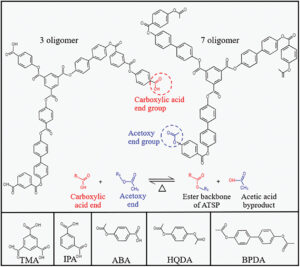 Vitrimers, although categorized as thermosetting polymers, differ from traditional ones in that their thermally induced crosslinks undergo reconfiguration through covalent bond exchanges in response to thermal stimuli. Exchangeable bonds present significant and distinctive advantages for thermoset-based aerospace composites, facilitating capabilities such as self-repair and crack arrest through molecular bridging. In this work, the self-healing behavior of four different blends of Aromatic Thermosetting Copolyester (ATSP) coatings, which are high-performance vitrimer polymers, is tested by introducing micro-scratches on the surface and healing them at higher temperatures. In three blends, the scratches are completely healed indicating complete repair. This property of the ATSP coatings can be useful in extreme conditions where micro-cracks lead to failure. The healing ability of the vitrimers is discussed in terms of their mechanical properties and morphological parameters such as branch density.
Vitrimers, although categorized as thermosetting polymers, differ from traditional ones in that their thermally induced crosslinks undergo reconfiguration through covalent bond exchanges in response to thermal stimuli. Exchangeable bonds present significant and distinctive advantages for thermoset-based aerospace composites, facilitating capabilities such as self-repair and crack arrest through molecular bridging. In this work, the self-healing behavior of four different blends of Aromatic Thermosetting Copolyester (ATSP) coatings, which are high-performance vitrimer polymers, is tested by introducing micro-scratches on the surface and healing them at higher temperatures. In three blends, the scratches are completely healed indicating complete repair. This property of the ATSP coatings can be useful in extreme conditions where micro-cracks lead to failure. The healing ability of the vitrimers is discussed in terms of their mechanical properties and morphological parameters such as branch density.
-
“Complex cure kinetics of self-healing copolyester vitrimers via isothermal thermogravimetric analysis” Polymer Testing, 2025.
 Thermogravimetric Analysis (TGA) is a valuable tool for studying chemical reactions that release volatile compounds. Constant-temperature TGA can be particularly useful for polymer cure reactions with complex, time-evolving phenomenology, by ensuring time and temperature effects remain separable. In this work, a compound isothermal TGA methodology is developed to study the cure process of high-performance vitrimers known as Aromatic Thermosetting coPolyesters (ATSP). By fitting observed mass loss to a nondimensional phenomenological model with generalized terms and introducing additional nonphysical terms to account both known and suspected non-cure behaviors, changes in cure kinetics were evaluated across a wide range of temperatures (210°C–380 °C). The activation of the added nonphysical terms was used to differentiate between expected cure behavior (240°C–340 °C), and cures involving precursor decomposition (>340 °C). An unexpected cure-like reaction below cure temperature (<240 °C) was hypothesized to correspond to self-healing bond exchange, which is well-understood to cause changes in molecular weight in thermoplastic polyesters. This was directly validated via evolved gas analysis, and activation energies were calculated for the cure-dominant region of the reaction. These activation energies were found to be similar across different polymer formulations. When combined with significant observed mass loss below the expected cure temperature and findings in prior work, this indicates that the apparent cure process may be driven by thermodynamically-favorable bond exchange reactions.
Thermogravimetric Analysis (TGA) is a valuable tool for studying chemical reactions that release volatile compounds. Constant-temperature TGA can be particularly useful for polymer cure reactions with complex, time-evolving phenomenology, by ensuring time and temperature effects remain separable. In this work, a compound isothermal TGA methodology is developed to study the cure process of high-performance vitrimers known as Aromatic Thermosetting coPolyesters (ATSP). By fitting observed mass loss to a nondimensional phenomenological model with generalized terms and introducing additional nonphysical terms to account both known and suspected non-cure behaviors, changes in cure kinetics were evaluated across a wide range of temperatures (210°C–380 °C). The activation of the added nonphysical terms was used to differentiate between expected cure behavior (240°C–340 °C), and cures involving precursor decomposition (>340 °C). An unexpected cure-like reaction below cure temperature (<240 °C) was hypothesized to correspond to self-healing bond exchange, which is well-understood to cause changes in molecular weight in thermoplastic polyesters. This was directly validated via evolved gas analysis, and activation energies were calculated for the cure-dominant region of the reaction. These activation energies were found to be similar across different polymer formulations. When combined with significant observed mass loss below the expected cure temperature and findings in prior work, this indicates that the apparent cure process may be driven by thermodynamically-favorable bond exchange reactions.2024
-
“Tough Monolayer Silver Nanowire-Reinforced Double-Layer Graphene” ACS Applied Materials and Interfaces, 2024.
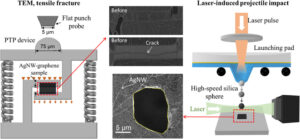 Mixed-dimensional nanomaterials composed of one-dimensional (1D) and two-dimensional (2D) nanomaterials, such as graphene–silver nanowire (AgNW) composite sandwiched structures, are promising candidates as building blocks for multifunctional structures and materials. However, their mechanical behavior and failure mechanism have not yet been fully understood. In this work, we have performed integrated experimental, theoretical, and numerical studies to explore the performance and failure modes of graphene–AgNW composite under tensile and impact loading conditions. In situ tensile tests using a nanoindenter, implemented with a push-to-pull device and a laser-induced projectile impact test system, are used to shed light on load-bearing mechanisms in graphene–AgNW composites. Multiple failure modes have been observed in both experimental setups and analyzed with numerical and theoretical models. Results show that in the tensile loading the distribution of AgNW, as characterized by the effective free length, is the key parameter determining the failure mode. As for the impact failure scenarios, compared with failure modes observed in pure graphene cases, the mechanical reinforcing effect of AgNW will transform the failure mode from a scattered tensile fracture along radial directions to a shear failure that is constrained in a relatively local domain. Theoretical analysis using shear lag modeling, Timoshenko plate theory, molecular dynamics modeling, and finite element modeling approaches are adopted to further establish the failure modes.
Mixed-dimensional nanomaterials composed of one-dimensional (1D) and two-dimensional (2D) nanomaterials, such as graphene–silver nanowire (AgNW) composite sandwiched structures, are promising candidates as building blocks for multifunctional structures and materials. However, their mechanical behavior and failure mechanism have not yet been fully understood. In this work, we have performed integrated experimental, theoretical, and numerical studies to explore the performance and failure modes of graphene–AgNW composite under tensile and impact loading conditions. In situ tensile tests using a nanoindenter, implemented with a push-to-pull device and a laser-induced projectile impact test system, are used to shed light on load-bearing mechanisms in graphene–AgNW composites. Multiple failure modes have been observed in both experimental setups and analyzed with numerical and theoretical models. Results show that in the tensile loading the distribution of AgNW, as characterized by the effective free length, is the key parameter determining the failure mode. As for the impact failure scenarios, compared with failure modes observed in pure graphene cases, the mechanical reinforcing effect of AgNW will transform the failure mode from a scattered tensile fracture along radial directions to a shear failure that is constrained in a relatively local domain. Theoretical analysis using shear lag modeling, Timoshenko plate theory, molecular dynamics modeling, and finite element modeling approaches are adopted to further establish the failure modes.
-
“Review of machine learning applications for defect detection in composite materials” Machine Learning with Applications, 2024.
Machine learning (ML)
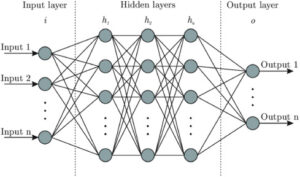 techniques have shown promising applications in a broad range of topics in engineering, composite materials behavior analysis, and manufacturing. This paper reviews successful ML implementations for defect and damage identification and progression in composites. The focus is on predicting composites’ responses under specific loads and environments and optimizing setting and imperfection sensitivity. Discussions and recommendations toward promising ML implementation practices for fruitful interpretable results in the composites’ analysis are provided.
techniques have shown promising applications in a broad range of topics in engineering, composite materials behavior analysis, and manufacturing. This paper reviews successful ML implementations for defect and damage identification and progression in composites. The focus is on predicting composites’ responses under specific loads and environments and optimizing setting and imperfection sensitivity. Discussions and recommendations toward promising ML implementation practices for fruitful interpretable results in the composites’ analysis are provided.
-
“Influence of nanofiller surface treatment on mechanical properties of pyrolyzed ceramic nanocomposites”Ceramics International, 2024.
The brittleness and limited plastic deformation of ceramics restrict their applications.
 In this work, the effects of pristine (CNTP), functionalized (CNTOH, CNTCOOH) and silanized MWCNTs on the mechanical properties of Silicon Carbide obtained by pyrolyzing polycarbosilane SMP-10 were studied. Functionalization with 3-glycidoxypropyltrimethoxy was analyzed through dispersion stability, zeta potential, and EDS analyses, revealing increased silicon content and colloidal stability in silanized MWCNTs. However, silanized MWCNTs led to reduced mechanical properties in composites, while untreated MWCNTs (CNTP, CNTOH, CNTCOOH), showed a substantial increase in modulus by 74.2 %, 86.9 %, and 30.5 %, respectively. The observed enhancement in mechanical properties exceeded the outcomes predicted by the rule of mixtures, suggesting notable morphological changes induced by MWCNTs. Potential underlying factors including toughening mechanisms and changes in porosity were evaluated and discussed in depth. Composites with untreated MWCNTs showed nearly a two-fold increase in fracture toughness. This work shows a streamlined approach for the development of ceramic nanocomposites (CNCs), achieving significant improvement in mechanical properties through pyrolysis, surpassing traditional methods reliant on densification processes. These findings demonstrate the substantial potential of CNCs, enhancing their suitability for advanced engineering applications.
In this work, the effects of pristine (CNTP), functionalized (CNTOH, CNTCOOH) and silanized MWCNTs on the mechanical properties of Silicon Carbide obtained by pyrolyzing polycarbosilane SMP-10 were studied. Functionalization with 3-glycidoxypropyltrimethoxy was analyzed through dispersion stability, zeta potential, and EDS analyses, revealing increased silicon content and colloidal stability in silanized MWCNTs. However, silanized MWCNTs led to reduced mechanical properties in composites, while untreated MWCNTs (CNTP, CNTOH, CNTCOOH), showed a substantial increase in modulus by 74.2 %, 86.9 %, and 30.5 %, respectively. The observed enhancement in mechanical properties exceeded the outcomes predicted by the rule of mixtures, suggesting notable morphological changes induced by MWCNTs. Potential underlying factors including toughening mechanisms and changes in porosity were evaluated and discussed in depth. Composites with untreated MWCNTs showed nearly a two-fold increase in fracture toughness. This work shows a streamlined approach for the development of ceramic nanocomposites (CNCs), achieving significant improvement in mechanical properties through pyrolysis, surpassing traditional methods reliant on densification processes. These findings demonstrate the substantial potential of CNCs, enhancing their suitability for advanced engineering applications.
-
“Regional pathways for all-electric aircraft to reduce aviation sector greenhouse gas emissions” Applied Energy Volume 373 , 1 November 2024, 123831
 Forecasted growth in aviation sector emissions has motivated research into reduced-emissions aircraft designs. All-electric aircraft (AEA) are of unique interest due to negligible in-flight emissions. In contrast to fuel-based aircraft, AEA emissions vary depending on power sector emissions intensity at point of departure. The present work identifies regional pathways for future AEA to reduce greenhouse gas emissions through use of novel energy and emissions models spanning the entirety of the domestic commercial aviation sector across eight separate scenarios considering different emerging battery cells and emissions scenarios. While regions with high power sector emissions intensity are ill-suited for future electrification, clear regional potential for future AEA is demonstrated, with flight networks in the Pacific Northwest, California, and the East Coast. Airports in cities such as Atlanta and Washington, D.C. are clear potential candidates for future AEA hubs, while electrifying flights between Portland, Oregon, and Seattle, Washington offers greatest potential impact.
Forecasted growth in aviation sector emissions has motivated research into reduced-emissions aircraft designs. All-electric aircraft (AEA) are of unique interest due to negligible in-flight emissions. In contrast to fuel-based aircraft, AEA emissions vary depending on power sector emissions intensity at point of departure. The present work identifies regional pathways for future AEA to reduce greenhouse gas emissions through use of novel energy and emissions models spanning the entirety of the domestic commercial aviation sector across eight separate scenarios considering different emerging battery cells and emissions scenarios. While regions with high power sector emissions intensity are ill-suited for future electrification, clear regional potential for future AEA is demonstrated, with flight networks in the Pacific Northwest, California, and the East Coast. Airports in cities such as Atlanta and Washington, D.C. are clear potential candidates for future AEA hubs, while electrifying flights between Portland, Oregon, and Seattle, Washington offers greatest potential impact.
-
“Processing and Mechanics of Aromatic Vitrimeric Composites at Elevated Temperatures and Healing Performance” J. Compos. Sci. 2024, 8(7).
Carbon fiber reinforced polymer (CFRP) composites are renowned for their exceptional mechanical properties, with applications in industries such as automotive, aerospace, medical, civil, and beyond. Despite these merits, a significant challenge in CFRPs lies in their repairability and maintenance. This study, for the first time, delves into the processing and self-healing capability of aromatic thermosetting co-polyester vitrimer-based carbon fiber composites through mechanical testing. Vitrimers are an emerging class of thermosetting polymers, which, owing to their exchangeable covalent bonds, enable the re-formation of bonds across cracks.
 The specific vitrimer chosen for this study is an aromatic thermosetting co-polyester (ATSP). The mechanical properties of samples were analyzed initially through three-point bending (3PB) testing at room temperature before and after healing (by curing samples for 2 h at 280 °C). Samples were also 3PB tested at 100 °C to analyze their mechanical properties at an elevated temperature for comparison to the samples tested at room temperature. To investigate the fracture properties, optical microscopy images of samples were taken after 3PB tests, which were analyzed to observe crack initiation and crack growth behavior. Through load–displacement curves from double cantilever beam (DCB) mechanical testing, the Mode I crack initiation fracture toughness values of self-healed composites and control composites were calculated to evaluate healing efficiency in ATSP CFRP composites cured at 280 °C for 2 h. Scanning electron microscopy (SEM) showed a similar surface morphology of cracks before and after self-healing. Micro-computed tomography (CT) X-ray imaging confirmed that the healed samples closely resembled the as-fabricated ones, with the exception of some manufacturing voids, caused by outgassing in the initial healing cycle. This research demonstrated the ability for the in situ repair of ATSP CFRPs by restoring the fracture toughness to values comparable to the pristine composite (~289 J/m2).
The specific vitrimer chosen for this study is an aromatic thermosetting co-polyester (ATSP). The mechanical properties of samples were analyzed initially through three-point bending (3PB) testing at room temperature before and after healing (by curing samples for 2 h at 280 °C). Samples were also 3PB tested at 100 °C to analyze their mechanical properties at an elevated temperature for comparison to the samples tested at room temperature. To investigate the fracture properties, optical microscopy images of samples were taken after 3PB tests, which were analyzed to observe crack initiation and crack growth behavior. Through load–displacement curves from double cantilever beam (DCB) mechanical testing, the Mode I crack initiation fracture toughness values of self-healed composites and control composites were calculated to evaluate healing efficiency in ATSP CFRP composites cured at 280 °C for 2 h. Scanning electron microscopy (SEM) showed a similar surface morphology of cracks before and after self-healing. Micro-computed tomography (CT) X-ray imaging confirmed that the healed samples closely resembled the as-fabricated ones, with the exception of some manufacturing voids, caused by outgassing in the initial healing cycle. This research demonstrated the ability for the in situ repair of ATSP CFRPs by restoring the fracture toughness to values comparable to the pristine composite (~289 J/m2).
2023
-
“Market capabilities and environmental impact of all-electric aircraft” Transportation Research Part D: Transport and Environment, 2023.
The transportation sector accounts for 28% of US-based and 14% of global greenhouse gas emissions.
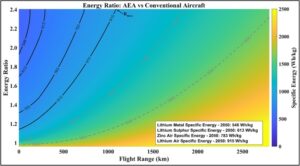 Transitioning from hydrocarbon-powered vehicles to electric vehicles such as all-electric aircraft (AEA) in parallel with use of reduced-emissions power sources is one possible method to curtail future sector emissions. However, AEA market capabilities and environmental impact are uncertain and insufficiently quantified in the literature. The present work evaluates AEA in the United States on national and state-by-state bases through 2050, considering four emerging battery architectures and two emissions scenarios. AEA using lithium-air cells with a projected specific energy of 915 Wh/kg could achieve 46.6% of total domestic commercial passenger share and 20.9% of total domestic commercial revenue passenger kilometers (RPK) by 2050, corresponding to a net CO2-equivalent emissions reduction of 1.02% – 19.8%. This work demonstrates clear potential for AEA, although achieving substantive aviation sector emissions reductions requires transition to reduced-emissions power generation.
Transitioning from hydrocarbon-powered vehicles to electric vehicles such as all-electric aircraft (AEA) in parallel with use of reduced-emissions power sources is one possible method to curtail future sector emissions. However, AEA market capabilities and environmental impact are uncertain and insufficiently quantified in the literature. The present work evaluates AEA in the United States on national and state-by-state bases through 2050, considering four emerging battery architectures and two emissions scenarios. AEA using lithium-air cells with a projected specific energy of 915 Wh/kg could achieve 46.6% of total domestic commercial passenger share and 20.9% of total domestic commercial revenue passenger kilometers (RPK) by 2050, corresponding to a net CO2-equivalent emissions reduction of 1.02% – 19.8%. This work demonstrates clear potential for AEA, although achieving substantive aviation sector emissions reductions requires transition to reduced-emissions power generation.
-
“Fuel-Driven Redox Reactions in Electrolyte-Free Polymer Actuators for Soft Robotics” ACS Appl. Mater. Interfaces, 2023.
Polymers that undergo shape changes in response to external stimuli can serve as actuators and offer significant potential in a variety of technologies, including biomimetic artificial muscles and soft robotics.
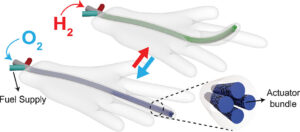 Current polymer artificial muscles possess major challenges for various applications as they often require extreme and non-practical actuation conditions. Thus, exploring actuators with new or underutilized stimuli may broaden the application of polymer-based artificial muscles. Here, we introduce an all-solid fuel-powered actuator that contracts and expands when exposed to H2 and O2 via redox reactions. This actuator demonstrates a fully reversible actuation magnitude of up to 3.8% and achieves a work capacity of 120 J/kg. Unlike traditional chemical actuators, our actuator eliminates the need for electrolytes, electrodes, and the application of external voltage. Moreover, it offers athermal actuation by avoiding the drawbacks of thermal actuators. Remarkably, the actuator maintains its actuated position under load when not stimulated, without consuming energy (i.e., catch state). These fuel-powered fiber actuators were embedded in a soft humanoid hand to demonstrate finger-bending motions. In terms of two main actuation metrics, stress-free contraction strain and blocking stress, the presented artificial muscle outperforms reported polymer redox actuators. The fuel-powered actuator developed in this work creates new avenues for the application of redox polymers in soft robotics and artificial muscles.
Current polymer artificial muscles possess major challenges for various applications as they often require extreme and non-practical actuation conditions. Thus, exploring actuators with new or underutilized stimuli may broaden the application of polymer-based artificial muscles. Here, we introduce an all-solid fuel-powered actuator that contracts and expands when exposed to H2 and O2 via redox reactions. This actuator demonstrates a fully reversible actuation magnitude of up to 3.8% and achieves a work capacity of 120 J/kg. Unlike traditional chemical actuators, our actuator eliminates the need for electrolytes, electrodes, and the application of external voltage. Moreover, it offers athermal actuation by avoiding the drawbacks of thermal actuators. Remarkably, the actuator maintains its actuated position under load when not stimulated, without consuming energy (i.e., catch state). These fuel-powered fiber actuators were embedded in a soft humanoid hand to demonstrate finger-bending motions. In terms of two main actuation metrics, stress-free contraction strain and blocking stress, the presented artificial muscle outperforms reported polymer redox actuators. The fuel-powered actuator developed in this work creates new avenues for the application of redox polymers in soft robotics and artificial muscles.
-
“Fracture Toughness Characteristics of Stacked Bilayer Graphene via Far-Field Displacement Measurements” Small, 2023.
Mechanical properties of graphene, e.g., strength, modulus, and fracture toughness are extremely sensitive to flaws. Here the fracture properties of stacked bilayer graphene sheets (SBLG) are reported, obtained via stacking two individually grown graphene sheets.
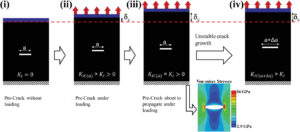 The SBLG is presented here as a building block for flaw-resilient nanomaterials. The fracture properties of freestanding SBLG sheets, suspended on transmission electron microscope (TEM) grids, are characterized by stretching the TEM grid inside an scanning electron microscope (SEM) chamber and monitoring the local displacements in real-time. The fracture toughness is measured and expressed as a function of the critical displacement required to propagate existing cracks in the experiment via computational models. This approach decouples force and displacements measurements, and utilizes the known elastic modulus along with the known displacement boundary conditions at the onset of crack growth to estimate the far field force and stress. This strategy represents a breakthrough in nanoscale fracture mechanics for statistical analysis and high throughput experimens on multiple samples at a time. Results demonstrate that the SBLG is markedly tougher than as-grown single or multilayer graphene, with a mode I fracture toughness of ≈28.06 ± 7.5 MPa.sqrt(m). The mechanisms leading to a higher toughness of SBLG are also analyzed and discussed.
The SBLG is presented here as a building block for flaw-resilient nanomaterials. The fracture properties of freestanding SBLG sheets, suspended on transmission electron microscope (TEM) grids, are characterized by stretching the TEM grid inside an scanning electron microscope (SEM) chamber and monitoring the local displacements in real-time. The fracture toughness is measured and expressed as a function of the critical displacement required to propagate existing cracks in the experiment via computational models. This approach decouples force and displacements measurements, and utilizes the known elastic modulus along with the known displacement boundary conditions at the onset of crack growth to estimate the far field force and stress. This strategy represents a breakthrough in nanoscale fracture mechanics for statistical analysis and high throughput experimens on multiple samples at a time. Results demonstrate that the SBLG is markedly tougher than as-grown single or multilayer graphene, with a mode I fracture toughness of ≈28.06 ± 7.5 MPa.sqrt(m). The mechanisms leading to a higher toughness of SBLG are also analyzed and discussed.
-
“Heat-Shielding Nanobrick Wall for Carbon Fiber-Reinforced Polymer Composites” ACS Appl. Polym. Mater., 2023.
Owing to their excellent mechanical properties, carbon fiber-reinforced polymer (CFRP) composites have a broad spectrum of applications in aerospace, civil engineering, automotive, and numerous industrial fields.
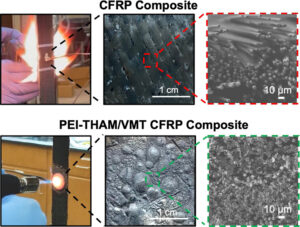 Despite their many advantages, the inherent lack of thermal stability of the polymer matrix results in the loss of the composite’s mechanical properties when exposed to elevated temperatures. In an effort to provide thermal protection, a multilayer film composed of tris(hydroxymethyl)-aminomethane (THAM)-buffered polyethylenimine (PEI) and vermiculite (VMT) clay was deposited on CFRP composites via layer-by-layer assembly. When subjected to the flame from a butane torch and mechanical loading, the polymer–clay nanobrick wall provides substantial thermal insulation, decreasing the temperature on the backside of the CFRP composites by as much as 100 °C. The PEI-THAM/VMT coating also helps to maintain the storage modulus of the composite and offers significant protection from oxidative degradation, as confirmed by dynamic mechanical analysis and X-ray photoelectron spectroscopy. The performance of this polymer–clay multilayer film provides excellent thermal barrier that can be used to protect advanced composite materials from extreme heat.
Despite their many advantages, the inherent lack of thermal stability of the polymer matrix results in the loss of the composite’s mechanical properties when exposed to elevated temperatures. In an effort to provide thermal protection, a multilayer film composed of tris(hydroxymethyl)-aminomethane (THAM)-buffered polyethylenimine (PEI) and vermiculite (VMT) clay was deposited on CFRP composites via layer-by-layer assembly. When subjected to the flame from a butane torch and mechanical loading, the polymer–clay nanobrick wall provides substantial thermal insulation, decreasing the temperature on the backside of the CFRP composites by as much as 100 °C. The PEI-THAM/VMT coating also helps to maintain the storage modulus of the composite and offers significant protection from oxidative degradation, as confirmed by dynamic mechanical analysis and X-ray photoelectron spectroscopy. The performance of this polymer–clay multilayer film provides excellent thermal barrier that can be used to protect advanced composite materials from extreme heat.
-
“Machine learning-based defect characterization in anisotropic materials with IR-thermography synthetic data” Composites Science and Technology, 2023.
Infrared (IR) thermography (IRT) is a non-destructive testing inspection technique widely used in numerous applications for void and defect detection in various materials such as fiber-reinforced composites.
 The IRT implementation requires solving the inverse heat transfer problem, i.e., calculating the defect attributes (e.g., shape, size, location) from a measured temporal and spatial surface temperature variation. This inverse problem, unlike its equivalent forward problem, is ill-posed and the uniqueness of the solution is not proven. To tackle this challenge, the k-nearest neighbors (k-NN) machine learning (ML) algorithm is employed to provide a model for predicting a penny-shaped defect size, thickness, and location in composite laminates. The study is based on simulations and synthetic data produced by ABAQUS finite element analysis (FEA) of the heat transfer model in defective composites to train the ML algorithm. The surface temperature vs. time and vs. distance diagrams are extracted from the FEA. The data diagrams are then used to extract the training features of the ML by considering the physics of the problem. This ML is trained by 502 FEA run data sets where firstly 10 features, and then 4 features, are selected from the mentioned FEA diagrams to predict the defect traits.
The IRT implementation requires solving the inverse heat transfer problem, i.e., calculating the defect attributes (e.g., shape, size, location) from a measured temporal and spatial surface temperature variation. This inverse problem, unlike its equivalent forward problem, is ill-posed and the uniqueness of the solution is not proven. To tackle this challenge, the k-nearest neighbors (k-NN) machine learning (ML) algorithm is employed to provide a model for predicting a penny-shaped defect size, thickness, and location in composite laminates. The study is based on simulations and synthetic data produced by ABAQUS finite element analysis (FEA) of the heat transfer model in defective composites to train the ML algorithm. The surface temperature vs. time and vs. distance diagrams are extracted from the FEA. The data diagrams are then used to extract the training features of the ML by considering the physics of the problem. This ML is trained by 502 FEA run data sets where firstly 10 features, and then 4 features, are selected from the mentioned FEA diagrams to predict the defect traits.
-
“Mechanics – Microstructure relations in 1D, 2D and mixed dimensional carbon nanomaterials” Carbon, 2023.
Utilizing 1D and 2D carbon nanomaterials to develop resilient and strong multifunctional composites has been a common theme in the field of nanomaterials in the past two decades. This theme is partly driven by the strong bonds between carbon atoms and the variety in bonding which translates into a wide variety of carbon nanomaterial types. It was once envisioned that CNT yarns would replace carbon fibers (CFs), an industry’s gold standard for load bearing.
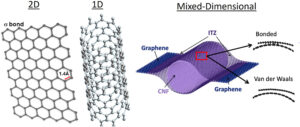 However, the dream of developing super-strong materials based on carbon nanomaterials is yet to be fulfilled. In this paper, we have systematically reviewed the strength, fracture and failure mechanisms of 1D, including carbon nanotubes and carbon nanofibers, and 2D carbon materials, mainly graphene. For any physical quantity including strength, the measured values and the measurement techniques/protocols are inherently coupled. Therefore, the experimental approaches and the reported mechanical properties are reviewed together to assist with a better understanding of the true and engineering mechanical properties. The factors which limit strength and cause failure, especially the inevitable defects commonly observed in both 1D and 2D carbon nanomaterials, are discussed. Afterwards, the mixed dimensional carbon nanomaterials, where the 1D nanomaterials are used as reinforcement of 2D materials, is discussed towards developing super-tough structural materials. At the end, potential future research directions on carbon nanomaterials for load bearing is briefly discussed.
However, the dream of developing super-strong materials based on carbon nanomaterials is yet to be fulfilled. In this paper, we have systematically reviewed the strength, fracture and failure mechanisms of 1D, including carbon nanotubes and carbon nanofibers, and 2D carbon materials, mainly graphene. For any physical quantity including strength, the measured values and the measurement techniques/protocols are inherently coupled. Therefore, the experimental approaches and the reported mechanical properties are reviewed together to assist with a better understanding of the true and engineering mechanical properties. The factors which limit strength and cause failure, especially the inevitable defects commonly observed in both 1D and 2D carbon nanomaterials, are discussed. Afterwards, the mixed dimensional carbon nanomaterials, where the 1D nanomaterials are used as reinforcement of 2D materials, is discussed towards developing super-tough structural materials. At the end, potential future research directions on carbon nanomaterials for load bearing is briefly discussed.
-
“Fully integrated design of a stretchable kirigami-inspired micro-sized zinc–sulfur battery” Journal of Materials Chemistry A, 2023.
The successful development of flexible and wearable electronic devices has created an ever-increasing demand for electrochemically-efficient flexible/stretchable energy storage devices. 3D kirigami-inspired energy storage devices have recently emerged as a viable option for achieving high strain (stretchability) without compromising electrochemical properties. However, such devices suffer from poor energy and power densities compared to those with 1D-fiber-like and 2D planar configurations. To this end, this study reports the design and fabrication of the first stretchable micro-sized zinc–sulfur (Zn–S) battery with excellent electrochemical properties.
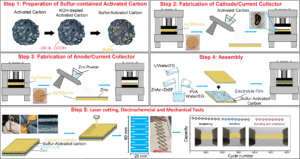 The kirigami-inspired quasi-solid-state Zn–S battery possesses notable features such as freeze resistance and exceptional stretchability. Additionally, the battery’s stretchability and bendability have been improved by incorporating a polymer-based current collector with low electrical resistivity. The micro-sized Zn–S battery with Ag/silicone composite current collectors offers an energy density of 184.8 mW h g−1 based on the AC-S/Zinc NPs (67.2 mW h g−1 based on the Zn–S cell), deformability (strain) of 200%, a long lifespan with excellent coulombic efficiency, and a discharge capacity retention rate of 90% over 800 cycles. The stretchable Zn–S presents no electrochemical performance degradation over 10[thin space (1/6-em)]000 cycles of stretching/releasing and an insignificant drop after 10[thin space (1/6-em)]000 stretching/bending (180°) cycles at 25 °C. The synthesized hydrogel electrolyte endows a minor drop (<10%) in electrochemical behavior after being subjected to 10[thin space (1/6-em)]000 stretching and bending cycles. The double-sided adhesive current collector makes it possible to fabricate multi-layered kirigami-inspired energy storage devices in serial and parallel configurations to meet stretchable electronics’ energy and power requirements.
The kirigami-inspired quasi-solid-state Zn–S battery possesses notable features such as freeze resistance and exceptional stretchability. Additionally, the battery’s stretchability and bendability have been improved by incorporating a polymer-based current collector with low electrical resistivity. The micro-sized Zn–S battery with Ag/silicone composite current collectors offers an energy density of 184.8 mW h g−1 based on the AC-S/Zinc NPs (67.2 mW h g−1 based on the Zn–S cell), deformability (strain) of 200%, a long lifespan with excellent coulombic efficiency, and a discharge capacity retention rate of 90% over 800 cycles. The stretchable Zn–S presents no electrochemical performance degradation over 10[thin space (1/6-em)]000 cycles of stretching/releasing and an insignificant drop after 10[thin space (1/6-em)]000 stretching/bending (180°) cycles at 25 °C. The synthesized hydrogel electrolyte endows a minor drop (<10%) in electrochemical behavior after being subjected to 10[thin space (1/6-em)]000 stretching and bending cycles. The double-sided adhesive current collector makes it possible to fabricate multi-layered kirigami-inspired energy storage devices in serial and parallel configurations to meet stretchable electronics’ energy and power requirements.
2022
-
“Multifunctional Quasi-Solid-State Zinc–Sulfur Battery” ACS Nano, 2022.
The introduction of structural energy storage devices into emerging markets, such as electric vehicles, is predominately hindered by weak energy density, safety concerns, and immaturity of the field in materials. Herein, fabrication and testing of a freeze-resistant, multifunctional quasi-solid-state zinc–sulfur battery (ZnS) are reported. To this end, an electrostatic spray coating technique was used to deposit a thin layer of sulfur on the highly porous, unidirectional activated carbon nanofibers (A-CNFs) as a load-bearing cathode. This technique could fill micro- and mesopores, and microsized channels with sulfur, achieving an extensive sulfur loading of 60 wt %.
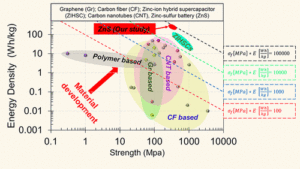 Several drawbacks of structural energy storage devices (applicability under varied climate conditions, poor electrochemical performance and mechanical properties) are addressed by initiating an antifreezing hydrogel electrolyte with a failure strain of over 200%. This electrolyte possesses ethylene glycol and an I2 additive as an antifreezing agent and redox mediator, respectively. The as-assembled ZnS battery offers a high energy density of 283 Wh/kg based on the CNF-S cathode (149 Wh/kg based on the ZnS cell) and mechanical properties beyond state-of-the-art structural energy storage devices with a tensile strength of 377 MPa, Young’s modulus of 16.7 GPa, and energy-to-failure of 4.5 MJ/m3. The electrochemomechanical properties of the ZnS battery were also investigated to elucidate the effects of electrochemical energy storage on mechanical properties and vice versa. Overall, the ZnS battery outperforms state-of-the-art structural energy storage devices in terms of energy storage and load-bearing capabilities.
Several drawbacks of structural energy storage devices (applicability under varied climate conditions, poor electrochemical performance and mechanical properties) are addressed by initiating an antifreezing hydrogel electrolyte with a failure strain of over 200%. This electrolyte possesses ethylene glycol and an I2 additive as an antifreezing agent and redox mediator, respectively. The as-assembled ZnS battery offers a high energy density of 283 Wh/kg based on the CNF-S cathode (149 Wh/kg based on the ZnS cell) and mechanical properties beyond state-of-the-art structural energy storage devices with a tensile strength of 377 MPa, Young’s modulus of 16.7 GPa, and energy-to-failure of 4.5 MJ/m3. The electrochemomechanical properties of the ZnS battery were also investigated to elucidate the effects of electrochemical energy storage on mechanical properties and vice versa. Overall, the ZnS battery outperforms state-of-the-art structural energy storage devices in terms of energy storage and load-bearing capabilities.
-
“Tunable Actuation of Humidity-Driven Artificial Muscles via Graphene Nanofillers” ACS Appl. Polym. Mater., 2022.
Humidity-responsive soft actuators can be driven by external stimuli and provide biomimetic environmental adaptations. Here, we report a humidity-responsive axial soft actuator of sulfonated polyether ether ketone which shows greatly tailorable actuation performance upon embedding graphene nanoplatelets (GNPs). Analysis of the experimental data shows that adding only 0.5 wt % GNP increases the actuation by 50% and provides a maximum actuation stroke of 24% and work capacity of 230 J/kg. In addition, 0.5 wt % GNP facilitates faster actuation, with significantly enhanced rates of both contraction and expansion.
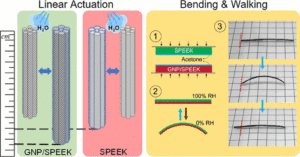 However, the addition of 1 wt % GNP slightly decreases the actuation magnitude. The nonmonotonic actuation performance was correlated with ion exchange capacity, water uptake, and GNP dispersion. By utilizing actuation magnitude tunability via GNP, the axial actuators were converted into a walking robot stacked of two active layers consisting of fibers of the same material system. The bilayer robot demonstrated self-crawling and locomotion ability in response to humidity changes. This study shows a uniquely tunable humidity actuator that demonstrates linear and bending actuation.
However, the addition of 1 wt % GNP slightly decreases the actuation magnitude. The nonmonotonic actuation performance was correlated with ion exchange capacity, water uptake, and GNP dispersion. By utilizing actuation magnitude tunability via GNP, the axial actuators were converted into a walking robot stacked of two active layers consisting of fibers of the same material system. The bilayer robot demonstrated self-crawling and locomotion ability in response to humidity changes. This study shows a uniquely tunable humidity actuator that demonstrates linear and bending actuation.
-
“Recycle and Reuse of Continuous Carbon Fibers from Thermoset Composites Using Joule Heating” ChemSusChem, 2022.
This study demonstrates a new and sustainable methodology for recycling continuous carbon fibers from end-of-life thermoset composite parts using Joule heating. This process addresses the longstanding challenge of efficiently recovering carbon fibers from composite scrap and reusing them to make fresh composites. The conductive carbon fibers volumetrically heat up when an electric current is passed through them, which in turn rapidly heats up the surrounding matrix sufficiently to degrade it. Fibers can be easily separated from the degraded matrix after the direct current (DC) heating process. Fibers reclaimed using this method were characterized to determine their tensile properties and surface chemistry, and compared against both as-received fibers and fibers recycled using conventional oven pyrolysis.
 The DC- and oven-recycled fibers yielded similar elastic modulus when compared against as-received fibers; however, an around 10–15 % drop was observed in the tensile strength of fibers recycled using either method. Surface characterization showed that DC-recycled fibers and as-received fibers had similar types of functional groups. To demonstrate the reusability of recycled fibers, composites were fabricated by impregnation with epoxy resin and curing. The mechanical properties of these recycled carbon fiber composites (rCFRCs) were compared against conventional recycling methods, and similar modulus and tensile strength values were obtained. This study establishes DC heating as a scalable out-of-oven approach for recycling carbon fibers.
The DC- and oven-recycled fibers yielded similar elastic modulus when compared against as-received fibers; however, an around 10–15 % drop was observed in the tensile strength of fibers recycled using either method. Surface characterization showed that DC-recycled fibers and as-received fibers had similar types of functional groups. To demonstrate the reusability of recycled fibers, composites were fabricated by impregnation with epoxy resin and curing. The mechanical properties of these recycled carbon fiber composites (rCFRCs) were compared against conventional recycling methods, and similar modulus and tensile strength values were obtained. This study establishes DC heating as a scalable out-of-oven approach for recycling carbon fibers.
-
“Zinc-ion hybrid supercapacitors with ultrahigh areal and gravimetric energy densities and long cycling life” Journal of Energy Chemistry, 2022.
Zinc ion hybrid supercapacitor (ZIHSC) with promising energy and power densities is an excellent answer to the ever-growing demand for energy storage devices. The restricted lifespan due to the dendrite formation on metallic zinc (Zn) is one of the main roadblocks. Herein, we investigate the electrochemical capability of oxygen-enriched porous carbon nanofibers (A-CNF) and nitrogen, oxygen-enriched porous carbon nanofibers (N-CNF) cathode materials for structural ZIHSCs. To this end, a series of samples with different chemical compositions (N and O contents) are prepared to present deep insight into the electrochemical mechanism between N/O doping and Zn-ion storage.
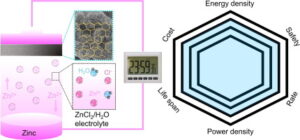 The as-prepared ZIHSC in the presence of N-CNF cathode and ZnCl2 electrolyte offers a battery-level gravimetric energy density of 143.2 Wh kg−1 at a power density of 367.1 W kg−1. The free-standing N-CNF electrodes in ZIHSCs enjoy delivering an outstanding areal energy density of 110.4 µWh cm−2 at 0.24 mW cm−2, excellent rate capability, and noticeable cycling stability over 10,000 cycles at 10 A g−1 with less than 7% decay. It was also concluded that active pyrrolic N dopants might deliver and facilitate more pseudocapacitance in ZIHSCs than other N configurations,resulting in higher adsorption/ desorption and insertion/extraction process of ZnCl+. Taking advantage of the beneficial properties of a free-standing continuous cathode, this novel generation of structural cathode material offers high areal and gravimetric energy densities and mechanical properties in a single zinc-ion-based package.
The as-prepared ZIHSC in the presence of N-CNF cathode and ZnCl2 electrolyte offers a battery-level gravimetric energy density of 143.2 Wh kg−1 at a power density of 367.1 W kg−1. The free-standing N-CNF electrodes in ZIHSCs enjoy delivering an outstanding areal energy density of 110.4 µWh cm−2 at 0.24 mW cm−2, excellent rate capability, and noticeable cycling stability over 10,000 cycles at 10 A g−1 with less than 7% decay. It was also concluded that active pyrrolic N dopants might deliver and facilitate more pseudocapacitance in ZIHSCs than other N configurations,resulting in higher adsorption/ desorption and insertion/extraction process of ZnCl+. Taking advantage of the beneficial properties of a free-standing continuous cathode, this novel generation of structural cathode material offers high areal and gravimetric energy densities and mechanical properties in a single zinc-ion-based package.
-
“Multifunctional quasi-solid-state zinc‐ion hybrid supercapacitors beyond state-of-the-art structural energy storage” Materials Today Physics, 2022.
Structural energy storage devices offer both electrochemical and mechanical performance in a single multifunctional platform, making them promising for weight- and/or volume-restricted applications such as electric vehicles, aircraft, and satellites.
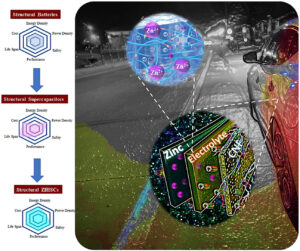 However, the development of state-of-the-art multifunctional energy storage is predominately hindered by poor energy density. Other parameters that influence the mechanical and electrochemical properties are also neglected, such as temperature, safety, etc. Herein, we assembled the first freeze-resistant, multifunctional quasi-solid-state zinc-ion hybrid supercapacitor (ZIHSC) using mechanically-strong hot-drawn, highly-porous nitrogen-doped carbon nanofibers as the load-bearing cathode and zinc foil as a paintable, malleable, low cost, highly safe, and robust anode. Considering the novel “two-birds-one-stone” strategy, the as-prepared multifunctional ZIHSCs outperform state-of-the-art structural energy storage devices in terms of a combination of energy storage and load-bearing capability. The structural ZIHSCs offer a battery-level gravimetric energy density of 113.1 Wh/kg, areal energy density of 300.0 μWh/cm2, strength of 308 MPa, Young’s modulus of 14.40 GPa, toughness of 1.82 MJ/m3, and cycling stability over 7500 cycles. In addition, multifunctional ZIHSCs offer outstanding electrochemical and mechanical performance under a wide range of temperatures from cryogenic (−25 °C) to ambient (+25 °C) conditions.
However, the development of state-of-the-art multifunctional energy storage is predominately hindered by poor energy density. Other parameters that influence the mechanical and electrochemical properties are also neglected, such as temperature, safety, etc. Herein, we assembled the first freeze-resistant, multifunctional quasi-solid-state zinc-ion hybrid supercapacitor (ZIHSC) using mechanically-strong hot-drawn, highly-porous nitrogen-doped carbon nanofibers as the load-bearing cathode and zinc foil as a paintable, malleable, low cost, highly safe, and robust anode. Considering the novel “two-birds-one-stone” strategy, the as-prepared multifunctional ZIHSCs outperform state-of-the-art structural energy storage devices in terms of a combination of energy storage and load-bearing capability. The structural ZIHSCs offer a battery-level gravimetric energy density of 113.1 Wh/kg, areal energy density of 300.0 μWh/cm2, strength of 308 MPa, Young’s modulus of 14.40 GPa, toughness of 1.82 MJ/m3, and cycling stability over 7500 cycles. In addition, multifunctional ZIHSCs offer outstanding electrochemical and mechanical performance under a wide range of temperatures from cryogenic (−25 °C) to ambient (+25 °C) conditions.
-
“Encapsulation and on-demand release of functional materials from conductive nanofibers via electrical signals” Multifunctional Materials, 2022.
The goal of this research is to establish a highly compact on-demand release platform for functional materials where porous nanofibers serve as the host, heat-based release trigger and temperature controller for regulated release.
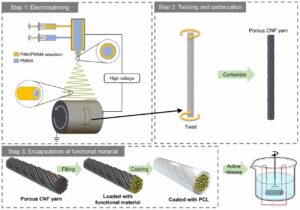 The ability to store functional materials in fibers and release them on demand via external signals may open up new frontiers in areas such as smart textiles and autonomous composites. The host material was porous carbon nanofibers (CNFs), which encapsulated functional materials, protected by a thin polymeric coating to thermally regulate the release. This platform was used to store Gentian violet (GV), an antibacterial material, and release it with highly controllable rates in aqueous environment. The high porosity of the CNF yarns, both inter- and intra-fiber porosity, resulted in a mass loading of as high as ∼50 wt%. The active release was triggered via passing electrical signals through CNF yarn backbone, thereby heating the coating. The rate of release as a function of temperature was measured. It was concluded that the release mechanism is via thermally augmented and reversible diffusion rates of GV and water through the coating. By applying electric current, the diffusion coefficient of the coating was increased, and the release rate dramatically increased in a reversible fashion by as much as 39×.
The ability to store functional materials in fibers and release them on demand via external signals may open up new frontiers in areas such as smart textiles and autonomous composites. The host material was porous carbon nanofibers (CNFs), which encapsulated functional materials, protected by a thin polymeric coating to thermally regulate the release. This platform was used to store Gentian violet (GV), an antibacterial material, and release it with highly controllable rates in aqueous environment. The high porosity of the CNF yarns, both inter- and intra-fiber porosity, resulted in a mass loading of as high as ∼50 wt%. The active release was triggered via passing electrical signals through CNF yarn backbone, thereby heating the coating. The rate of release as a function of temperature was measured. It was concluded that the release mechanism is via thermally augmented and reversible diffusion rates of GV and water through the coating. By applying electric current, the diffusion coefficient of the coating was increased, and the release rate dramatically increased in a reversible fashion by as much as 39×.
-
“Evaluating multifunctional efficiency of a structural battery composite via thermo-electro-chemical modeling” Multifunctional Materials, 2022.
The emerging research field of structural batteries aims to combine the functions of load bearing and energy storage to improve system-level energy storage in battery-powered vehicles and consumer products. Structural batteries, when implemented in electric vehicles, will be exposed to greater temperature fluctuations than conventional batteries in electric vehicles.
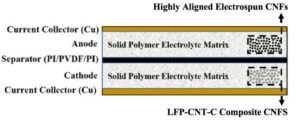 However, there is a lack of knowledge in public domains and scientific literature regarding how these thermal boundary conditions impact power capabilities of the structural batteries. To fill this gap, the present work simulates the transient temperature-dependent specific power capabilities of a high aspect ratio structural battery composite by solving the one-dimensional heat transfer equation with heat source terms and convective boundary conditions. Equivalent circuit modeling of resistivity-induced losses is used with a second-order finite difference method to examine battery performance. More than 60 different run configurations are evaluated in this work, examining how thermal boundary conditions and internal heat generation influence power capabilities and multifunctional efficiency of the structural battery. The simulated structural battery composite is shown to have good specific Young’s modulus (79.5%–80.3% of aluminum), a specific energy of 158 Wh kg−1, and specific power of 41.2–55.2 W kg−1, providing a multifunctional efficiency of 1.15–1.17 depending on configuration and thermal loading conditions and demonstrating the potential of load-bearing structural batteries to achieve mass savings. This work emphasizes the dependency of power efficiency on cell design and external environmental conditions. Insulating material is shown to improve multifunctional efficiency, particularly for low ambient temperatures. It is demonstrated that as cell temperature increases due to high ambient temperature or heat generation in the battery, the specific power efficiency increases exponentially due to a favorable nonlinear relation between ionic conductivity and cell temperature. The simulations also demonstrate a thermal feedback loop where resistivity-induced power losses can lead to self-regulation of cell temperature. This effect reduces run-averaged losses, particularly at low ambient temperatures.
However, there is a lack of knowledge in public domains and scientific literature regarding how these thermal boundary conditions impact power capabilities of the structural batteries. To fill this gap, the present work simulates the transient temperature-dependent specific power capabilities of a high aspect ratio structural battery composite by solving the one-dimensional heat transfer equation with heat source terms and convective boundary conditions. Equivalent circuit modeling of resistivity-induced losses is used with a second-order finite difference method to examine battery performance. More than 60 different run configurations are evaluated in this work, examining how thermal boundary conditions and internal heat generation influence power capabilities and multifunctional efficiency of the structural battery. The simulated structural battery composite is shown to have good specific Young’s modulus (79.5%–80.3% of aluminum), a specific energy of 158 Wh kg−1, and specific power of 41.2–55.2 W kg−1, providing a multifunctional efficiency of 1.15–1.17 depending on configuration and thermal loading conditions and demonstrating the potential of load-bearing structural batteries to achieve mass savings. This work emphasizes the dependency of power efficiency on cell design and external environmental conditions. Insulating material is shown to improve multifunctional efficiency, particularly for low ambient temperatures. It is demonstrated that as cell temperature increases due to high ambient temperature or heat generation in the battery, the specific power efficiency increases exponentially due to a favorable nonlinear relation between ionic conductivity and cell temperature. The simulations also demonstrate a thermal feedback loop where resistivity-induced power losses can lead to self-regulation of cell temperature. This effect reduces run-averaged losses, particularly at low ambient temperatures.2021
-
“Identification of the effect of nanofiller morphology on interlaminar fracture toughness of hybrid composites” Journal of Composite Materials, 2021.
Nanoscale reinforcements have the potential to improve mechanical properties of fiber reinforced composite. Here, effect of nanofiller morphology and dispersion in augmenting mode I fracture toughness of unidirectional carbon fiber reinforced composite materials is studied.
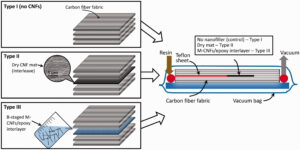 The nanofillers used is electrospun carbon nanofibers (CNFs). Unlike most nanofillers which are in particulate form, CNFs exist in both continuous nanofiber mat and particulate forms. This trait allowed us to compare the effect of particulate nanofillers (CNFs dispersed in B-staged epoxy) vs. dry mats on fracture toughness of composites while all other parameters are kept constant. To enhance CNFs-matrix interactions, a novel approach was utilized to functionalize CNFs surface with melamine, so that epoxy functional groups can form strong bonds to matrix. The improvement in mode I initiation fracture toughness with CNF mats was statistically significant, while in B-staged samples, statistical analysis revealed insignificant improvement. In addition, in both CNFs reinforced samples, crack propagation fracture toughness decreased with crack growth and approached that of the composites with no CNFs. The decline was steeper in samples with B-staged CNFs. This behavior was explained by evaluating fracture path via SEM imaging. It was concluded that while CNFs bridge crack tip initially and delay crack initiation, crack deflects towards a lower resistance path by tearing CNFs mat and propagating along resin-rich interface between CNFs and microfibers. These alternative and weaker fracture planes are more readily available in B-staged samples due to poor integration of the B-staged epoxy with the rest of the composite.
The nanofillers used is electrospun carbon nanofibers (CNFs). Unlike most nanofillers which are in particulate form, CNFs exist in both continuous nanofiber mat and particulate forms. This trait allowed us to compare the effect of particulate nanofillers (CNFs dispersed in B-staged epoxy) vs. dry mats on fracture toughness of composites while all other parameters are kept constant. To enhance CNFs-matrix interactions, a novel approach was utilized to functionalize CNFs surface with melamine, so that epoxy functional groups can form strong bonds to matrix. The improvement in mode I initiation fracture toughness with CNF mats was statistically significant, while in B-staged samples, statistical analysis revealed insignificant improvement. In addition, in both CNFs reinforced samples, crack propagation fracture toughness decreased with crack growth and approached that of the composites with no CNFs. The decline was steeper in samples with B-staged CNFs. This behavior was explained by evaluating fracture path via SEM imaging. It was concluded that while CNFs bridge crack tip initially and delay crack initiation, crack deflects towards a lower resistance path by tearing CNFs mat and propagating along resin-rich interface between CNFs and microfibers. These alternative and weaker fracture planes are more readily available in B-staged samples due to poor integration of the B-staged epoxy with the rest of the composite.
-
“Layer-by-Layer Assembly of Reduced Graphene Oxide and MXene Nanosheets for Wire-Shaped Flexible Supercapacitors” ACS Appl. Mater. Interfaces 2021.
As the demand for wearable electronic devices increases, interest in small, light, and deformable energy storage devices follows suit. Among these devices, wire-shaped supercapacitors (WSCs) are considered key components of wearable technology due to their geometric similarity to woven fiber.
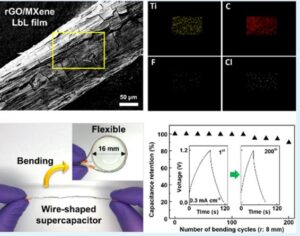 One potential method for creating WSC devices is the layer-by-layer (LbL) assembly technique, which is a “bottom-up” method for electrode fabrication. WSCs require conformal and adhesive coatings of the functional material to the wire-shaped substrate, which is difficult to obtain with other processing techniques such as vacuum filtration or spray-coating. However, the LbL assembly technique produces conformal and robust coatings that can be deposited onto a variety of substrates and shapes, including wires. In this study, we report WSCs made using the LbL assembly of alternating layers of positively charged reduced graphene oxide functionalized with poly(diallyldimethylammonium chloride) and negatively charged Ti3C2Tx MXene nanosheets conformally deposited on activated carbon yarns. In this construct, the added LbL film enhances capacitance, energy density, and power density by 240, 227, and 109%, respectively, relative to the uncoated activated carbon yarn, yielding high specific and volumetric capacitances (237 F g–1, 2193 F cm–3). In addition, the WSC possesses good mechanical stability, retaining 90% of its initial capacity after 200 bending cycles. This study demonstrates that LbL coatings on carbon yarns are promising as linear energy storage devices for fibrous electronics.
One potential method for creating WSC devices is the layer-by-layer (LbL) assembly technique, which is a “bottom-up” method for electrode fabrication. WSCs require conformal and adhesive coatings of the functional material to the wire-shaped substrate, which is difficult to obtain with other processing techniques such as vacuum filtration or spray-coating. However, the LbL assembly technique produces conformal and robust coatings that can be deposited onto a variety of substrates and shapes, including wires. In this study, we report WSCs made using the LbL assembly of alternating layers of positively charged reduced graphene oxide functionalized with poly(diallyldimethylammonium chloride) and negatively charged Ti3C2Tx MXene nanosheets conformally deposited on activated carbon yarns. In this construct, the added LbL film enhances capacitance, energy density, and power density by 240, 227, and 109%, respectively, relative to the uncoated activated carbon yarn, yielding high specific and volumetric capacitances (237 F g–1, 2193 F cm–3). In addition, the WSC possesses good mechanical stability, retaining 90% of its initial capacity after 200 bending cycles. This study demonstrates that LbL coatings on carbon yarns are promising as linear energy storage devices for fibrous electronics.
-
“Athermal artificial muscles with drastically improved work capacity from pH-Responsive coiled polymer fibers” Sensors and Actuators B: Chemical, 2021.
Polymeric artificial muscles are great candidates to replace traditional rigid actuators due to their lightweight nature and high actuation stroke.
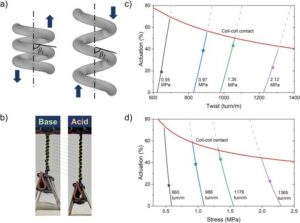 However, the actuation mechanism of many polymer artificial muscles relies on large temperature changes which may cause polymer degradation. Besides, having remotely detectable thermal IR signals is not suitable for some applications. Chemical stimulants, on the other hand, can operate polymer artificial muscles and address these limitations. In this paper, we evaluated the actuation response of athermal pH-responsive artificial muscles made of aligned and coiled fibers. We demonstrated that a coiled architecture can be utilized to simultaneously amplify actuation stroke and work capacity by benefitting from the anisotropic length and diameter changes of individual fibers in response to pH changes. Our coiled pH-responsive fibers can deliver up to 43 % contractive actuation stroke. The maximum obtained work capacity of 393 J/kg is 5 times higher than that of the aligned fiber counterpart. At an actuation stroke of 22 %, the polymer muscle lifts weights over 2000 times heavier relative to its own weight. A mechanistic model of coiled fibers revealed that the amplification of stroke and work capacity are owed to significant changes in the bending and torsional stiffness stemming from changes in elastic modulus and fiber diameter.
However, the actuation mechanism of many polymer artificial muscles relies on large temperature changes which may cause polymer degradation. Besides, having remotely detectable thermal IR signals is not suitable for some applications. Chemical stimulants, on the other hand, can operate polymer artificial muscles and address these limitations. In this paper, we evaluated the actuation response of athermal pH-responsive artificial muscles made of aligned and coiled fibers. We demonstrated that a coiled architecture can be utilized to simultaneously amplify actuation stroke and work capacity by benefitting from the anisotropic length and diameter changes of individual fibers in response to pH changes. Our coiled pH-responsive fibers can deliver up to 43 % contractive actuation stroke. The maximum obtained work capacity of 393 J/kg is 5 times higher than that of the aligned fiber counterpart. At an actuation stroke of 22 %, the polymer muscle lifts weights over 2000 times heavier relative to its own weight. A mechanistic model of coiled fibers revealed that the amplification of stroke and work capacity are owed to significant changes in the bending and torsional stiffness stemming from changes in elastic modulus and fiber diameter.
-
“Nanomechanical tests on continuous near-field electrospun PAN nanofibers reveal abnormal mechanical and morphology size effects” Polymer, 2021.
Polyacrylonitrile (PAN) nanofibers have long been the subject of studies as precursor for high performance materials such as carbon nanofibers. Here, we present the first effort to study the mechanical properties of PAN nanofibers fabricated via near field electrospinning, in which bending instability was completely suppressed. The method allowed for the collection of continuous single-strand PAN nanofibers with aspect ratios exceeding 106 on a spool (rotating target). By controlling the electrospinning parameters, such as solution concentration, voltage and distance, we demonstrated that the morphology and diameter of the PAN nanofiber were well controlled.
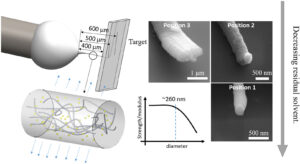 We also realized that slight changes in the distance can significantly change the shape of the cross section of the fibers, from a circular cross section to oval shaped (ribbons), which was explained in terms of solvent residues in the jet and momentum transfer between the fibers and the target, as the fibers reach the target. Our studies on individual PAN nanofibers revealed a strong mechanical size effect, in which reducing the diameter of the nanofibers from ∼290 nm to ∼200 nm, led to a large increase in modulus to as high as ∼9 GPa, among the highest in as-electrospun PAN nanofibers. The strong size effect was attributed to a loss in chain alignment in thicker electrospun nanofibers facilitated by the plasticizing effect of residual solvent. In comparison to conventional electrospinning, the NFES led to a significantly narrower diameter distribution. The demonstrated size-dependent morphology, mechanical properties of NFES PAN nanofibers provides a solid foundation for fabricating polymer nanofiber with controllable patterning and properties through NFES.
We also realized that slight changes in the distance can significantly change the shape of the cross section of the fibers, from a circular cross section to oval shaped (ribbons), which was explained in terms of solvent residues in the jet and momentum transfer between the fibers and the target, as the fibers reach the target. Our studies on individual PAN nanofibers revealed a strong mechanical size effect, in which reducing the diameter of the nanofibers from ∼290 nm to ∼200 nm, led to a large increase in modulus to as high as ∼9 GPa, among the highest in as-electrospun PAN nanofibers. The strong size effect was attributed to a loss in chain alignment in thicker electrospun nanofibers facilitated by the plasticizing effect of residual solvent. In comparison to conventional electrospinning, the NFES led to a significantly narrower diameter distribution. The demonstrated size-dependent morphology, mechanical properties of NFES PAN nanofibers provides a solid foundation for fabricating polymer nanofiber with controllable patterning and properties through NFES.
-
“All‐solid‐state supercapacitors based on yarns of Co3O4-anchored porous carbon nanofibers” Chemical Engineering Journal, in press 2020.
Developing an efficient all‐solid‐state structural supercapacitor with simultaneous high energy storage and load-bearing capabilities for reducing
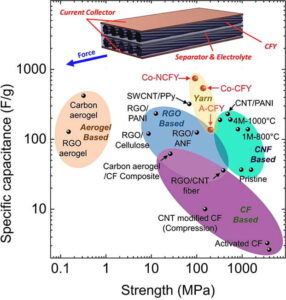 weight/volume in weight- / weight- restricted applications remains challenging. Relying only on the sole mechanism of the electrical double layer and the existing trade-offs between load bearing and energy storage requirements have limited the overall performance of carbon-based structural electrodes. Herein, we describe the development of ultrafine Co3O4-anchored highly-porous, hollow, N-doped carbon nanofiber yarns (Co-NCFY) as a high performance multifunctional structural electrode with a remarkable performance index representing mechanical and electrochemical properties. The device is designed to benefit from both the pseudocapacitance and double layer mechanisms to store energy. The Co-NCFY show promising electrochemical properties (electrochemical capacity of 713 F g−1 at 1 mV s-1, desirable cycling stability of > 92% at 20 A g−1 after > 8000 cycles, energy density of 45.4 Wh kg−1 at a power density of 209 W kg-1), and load-bearing capability (strength and young modulus of 87.4 MPa and 26.4 GPa, respectively). Taking into account both electrochemical and mechanical properties, the Co-NCFY outperform recently reported structural electrode materials (see Ashby chart in graphical abstract). These attractive attributes make Co-NCFY a unique structural electrode material for efficient structural energy storage devices.
weight/volume in weight- / weight- restricted applications remains challenging. Relying only on the sole mechanism of the electrical double layer and the existing trade-offs between load bearing and energy storage requirements have limited the overall performance of carbon-based structural electrodes. Herein, we describe the development of ultrafine Co3O4-anchored highly-porous, hollow, N-doped carbon nanofiber yarns (Co-NCFY) as a high performance multifunctional structural electrode with a remarkable performance index representing mechanical and electrochemical properties. The device is designed to benefit from both the pseudocapacitance and double layer mechanisms to store energy. The Co-NCFY show promising electrochemical properties (electrochemical capacity of 713 F g−1 at 1 mV s-1, desirable cycling stability of > 92% at 20 A g−1 after > 8000 cycles, energy density of 45.4 Wh kg−1 at a power density of 209 W kg-1), and load-bearing capability (strength and young modulus of 87.4 MPa and 26.4 GPa, respectively). Taking into account both electrochemical and mechanical properties, the Co-NCFY outperform recently reported structural electrode materials (see Ashby chart in graphical abstract). These attractive attributes make Co-NCFY a unique structural electrode material for efficient structural energy storage devices.2020
-
“Melt Electrospinning Polyethylene Fibers in Inert Atmosphere” Macromol. Mater. Eng. 2020, 305, 2000106.
Electrospinning is commonly used for fabrication of polymer fibers.
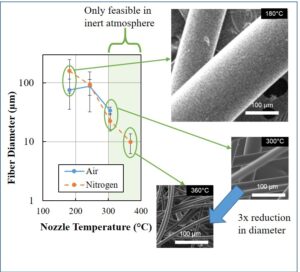 Melt electrospinning, instead of the commonly used solution electrospinning, offers many advantages in generating polymer fibers without using solvents. However, polymer melts have high viscosity which poses major limitations in producing low diameter fibers. Here, melt electrospinning is investigated at elevated temperatures in inert atmosphere to reduce fiber diameters while suppressing thermal degradation. Two types of spinneret configurations, syringe and wire, with two distinct outcomes are studied. In syringe‐based electrospinning, increasing the nozzle temperature from 300 to 360 °C in nitrogen reduced fiber diameter significantly from 33 ± 5 to 10 ± 4 µm. Electrospinning in nitrogen leads to formation of fibers even at a high nozzle temperature of 360 °C, while this temperature leads to thermal degradation when spinning in air. In contrast, increasing the temperature of wire electrospinning setup do not lead to a noticeable reduction in diameter. This is attributed to the viscosity‐dependent flow rate in this method. Increasing the temperature leads to increased flow rates, promoting the formation of thicker fibers, while the increased stretchability promotes the formation of thinner fibers. The results clearly demonstrate advantages of developing polymer microfibers in inert atmosphere to avoid thermal degradation with a temperature‐independent flow control.
Melt electrospinning, instead of the commonly used solution electrospinning, offers many advantages in generating polymer fibers without using solvents. However, polymer melts have high viscosity which poses major limitations in producing low diameter fibers. Here, melt electrospinning is investigated at elevated temperatures in inert atmosphere to reduce fiber diameters while suppressing thermal degradation. Two types of spinneret configurations, syringe and wire, with two distinct outcomes are studied. In syringe‐based electrospinning, increasing the nozzle temperature from 300 to 360 °C in nitrogen reduced fiber diameter significantly from 33 ± 5 to 10 ± 4 µm. Electrospinning in nitrogen leads to formation of fibers even at a high nozzle temperature of 360 °C, while this temperature leads to thermal degradation when spinning in air. In contrast, increasing the temperature of wire electrospinning setup do not lead to a noticeable reduction in diameter. This is attributed to the viscosity‐dependent flow rate in this method. Increasing the temperature leads to increased flow rates, promoting the formation of thicker fibers, while the increased stretchability promotes the formation of thinner fibers. The results clearly demonstrate advantages of developing polymer microfibers in inert atmosphere to avoid thermal degradation with a temperature‐independent flow control.
-
“Three-Dimensional Printing of Ceramics through “Carving” a Gel and “Filling in” the Precursor Polymer” ACS Appl. Mater. Interfaces 2020, 12, 28, 31984–31991
Achieving a viable process for three-dimensional (3D) printing of ceramics is a sought-after goal in a wide range of fields including electronics and sensors for harsh environments, microelectromechanical devices, energy storage materials, and structural materials, among others. Low laser absorption of ceramic powders renders available additive manufacturing (AM) technologies for metals not suitable for ceramics. Polymer solutions that can be converted to ceramics (preceramic polymers) offer a unique opportunity to 3D-print ceramics; however, due to the low viscosity of these polymers, so far, their 3D printing has only been possible by combining them with specialized light-sensitive agents and subsequently cross-linking them layer by layer by rastering an optical beam. The slow rate, lack of scalability to large specimens, and specialized chemistry requirements of this optical process are fundamental limitations. Here, we demonstrate 3D printing of ceramics enabled by dispensing the preceramic polymer at the tip of a moving nozzle into a gel that can reversibly switch between fluid and solid states, and subsequently thermally cross-linking the entire printed part “at-once” while still inside the same gel. The solid gel, which is composed of mineral oil and silica nanoparticles, converts to fluid at the tip of the moving nozzle, allows the polymer solution to be dispensed, and quickly returns to a solid state to maintain the geometry of the printed polymer both during printing and the subsequent high-temperature (160 °C) cross-linking. We retrieve the cross-linked part from the gel and convert it to ceramic by high-temperature pyrolysis. This scalable process opens up new opportunities for low-cost and high-speed production of complex three-dimensional ceramic parts and will be widely used for high temperature and corrosive environment applications, including electronics and sensors, microelectromechanical systems, energy and structural applications.
-
“A novel path towards synthesis of nitrogen-rich porous carbon nanofibers for high performance supercapacitors” Chemical Engineering Journal Volume 399, 1 November 2020, 125788
A facile and efficient nitrogen doping strategy is proposed to improve the nitrogen content, increase surface area,
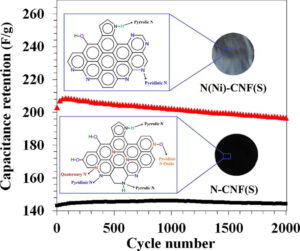 and tune the configuration of nitrogen-related defects in the carbon nanostructures for application as supercapacitors. To this end, carbon nanofibers (CNFs) were fabricated via pyrolysis of polyacrylonitrile (PAN) nanofibers with sacrificial polymers (PMMA). By lowering the interfacial tension between PAN and PMMA in DMF with the aid of surfactants, the size of the sacrificial PMMA islands in the continuous PAN phase was significantly reduced, promoting the formation of pores and increase the specific surface area (SSA) of the host CNF during pyrolysis. The synthesis of N-doped CNF with a controlled N-bonding structure was achieved by pyrolysis of precursor on Ni surface in the presence of melamine as a nitrogen source. We showed that the concentration and configuration of N-related defects in CNFs can be respectively enhanced and controlled by absorption of the oxygen-containing sites onto a metallic substrate. Furthermore, the surface area was also increased by absorbing oxygen on the Ni surface. The synthesized porous nitrogen-rich CNFs as a binder-free and free-standing electrode for supercapacitors demonstrated remarkable electrochemical capacitance, superb rate capability, and possessed excellent long-term stability over 10,000 cycles (capacitance retention of 94%).
and tune the configuration of nitrogen-related defects in the carbon nanostructures for application as supercapacitors. To this end, carbon nanofibers (CNFs) were fabricated via pyrolysis of polyacrylonitrile (PAN) nanofibers with sacrificial polymers (PMMA). By lowering the interfacial tension between PAN and PMMA in DMF with the aid of surfactants, the size of the sacrificial PMMA islands in the continuous PAN phase was significantly reduced, promoting the formation of pores and increase the specific surface area (SSA) of the host CNF during pyrolysis. The synthesis of N-doped CNF with a controlled N-bonding structure was achieved by pyrolysis of precursor on Ni surface in the presence of melamine as a nitrogen source. We showed that the concentration and configuration of N-related defects in CNFs can be respectively enhanced and controlled by absorption of the oxygen-containing sites onto a metallic substrate. Furthermore, the surface area was also increased by absorbing oxygen on the Ni surface. The synthesized porous nitrogen-rich CNFs as a binder-free and free-standing electrode for supercapacitors demonstrated remarkable electrochemical capacitance, superb rate capability, and possessed excellent long-term stability over 10,000 cycles (capacitance retention of 94%).
-
“Crosslinked network microstructure of carbon nanomaterials promotes flaw-tolerant mechanical response” Nanotechnology 31 315606
(2020)
Carbon nanomaterials, such as carbon nanotubes (CNTs) and carbon nanofibers (CNFs), are chemically inert in their highly graphitic forms.
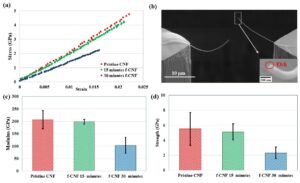 Various post processing methods can activate their surfaces to enhance their interactions with a host matrix in a nanocomposite. Chemical surface functionalization is used often. This method however can lead to major strength loss in nanomaterials stemming from induced surface defects (changing sp2 bonds to sp3 bonds). In this manuscript, we have experimentally studied the mechanical properties of the individual, pyrolysis-fabricated CNFs. These CNFs have a highly crosslinked 3D network of C–C bonds. The strength of CNFs has been studied as a function of O/C ratio. The loss in strength due to functionalization has been compared to that of other carbon nanomaterials with layered strcutures (CNT and graphene). Comparisons were also made with carbon microfibers. Fracture strength estimations of the critical flaw size in CNFs, CNTs and graphene were also made. The results revealed that despite having high surface area, carbon nanomaterials with crosslinked microstructure are resilient to flaws as big (deep) as 10–30 nm, while nanomaterials with layered structure (such as CNTs) experience a dramatic loss in strength with much lower flaw sizes. Hence, it seems that graphitic nanomaterials such as graphene and CNT have high strenght that, although higher than CNFs, comes at a cost to flaw tolerance and robustness. Since failure is often progressive, this work demonstrates a benefit that crosslinked nanomaterials have over highly graphitic ones, such as CNTs, in load bearing applications.
Various post processing methods can activate their surfaces to enhance their interactions with a host matrix in a nanocomposite. Chemical surface functionalization is used often. This method however can lead to major strength loss in nanomaterials stemming from induced surface defects (changing sp2 bonds to sp3 bonds). In this manuscript, we have experimentally studied the mechanical properties of the individual, pyrolysis-fabricated CNFs. These CNFs have a highly crosslinked 3D network of C–C bonds. The strength of CNFs has been studied as a function of O/C ratio. The loss in strength due to functionalization has been compared to that of other carbon nanomaterials with layered strcutures (CNT and graphene). Comparisons were also made with carbon microfibers. Fracture strength estimations of the critical flaw size in CNFs, CNTs and graphene were also made. The results revealed that despite having high surface area, carbon nanomaterials with crosslinked microstructure are resilient to flaws as big (deep) as 10–30 nm, while nanomaterials with layered structure (such as CNTs) experience a dramatic loss in strength with much lower flaw sizes. Hence, it seems that graphitic nanomaterials such as graphene and CNT have high strenght that, although higher than CNFs, comes at a cost to flaw tolerance and robustness. Since failure is often progressive, this work demonstrates a benefit that crosslinked nanomaterials have over highly graphitic ones, such as CNTs, in load bearing applications.
-
“Size-dependent Creep Master Curve of Individual Electrospun Polymer Nanofibers” Experimental Mechanics 60, pages763–773(2020)
While there is great interest in polymer nanofibers due to their high strength, methods to measure their time-temperature superposition (TTS) curves are lacking.
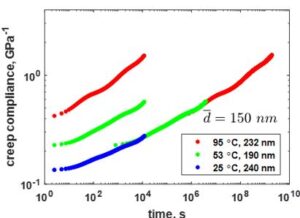 The objective of this work is to demonstrate one such method and thereby to predict room temperature creep compliance over many decades of time. A complimentary measurement is also presented to estimate the associated activation energy. The experimental method is demonstrated for polyacrylonitrile (PAN) nanofibers using an on-chip surface micromachined stepper motor actuator. It is first shown that the method yields good agreement with previous room temperature measurements. Subsequently, data up to 95 °C, near the glass transition temperature, is presented. Time-temperature superposition master curves are then constructed, and activation energies for two narrow diameter ranges (221 ± 27 nm and 150 ± 9 nm) are determined. The activation energy of the 221 nm fiber agrees well with the bulk PAN value, while the 150 nm fiber is 50% larger, indicating the importance of higher chain packing and reduced chain mobility in thinner fibers. TTS curves spanning 7 (221 nm) and 9 (150 nm) decades are presented. Over this time span the creep compliance increases by a factor of approximately 10 for each. This work demonstrates a viable method to measure polymer nanofiber TTS curves from which quantitative activation energy can be determined, and from which creep compliance values over time can be predicted.
The objective of this work is to demonstrate one such method and thereby to predict room temperature creep compliance over many decades of time. A complimentary measurement is also presented to estimate the associated activation energy. The experimental method is demonstrated for polyacrylonitrile (PAN) nanofibers using an on-chip surface micromachined stepper motor actuator. It is first shown that the method yields good agreement with previous room temperature measurements. Subsequently, data up to 95 °C, near the glass transition temperature, is presented. Time-temperature superposition master curves are then constructed, and activation energies for two narrow diameter ranges (221 ± 27 nm and 150 ± 9 nm) are determined. The activation energy of the 221 nm fiber agrees well with the bulk PAN value, while the 150 nm fiber is 50% larger, indicating the importance of higher chain packing and reduced chain mobility in thinner fibers. TTS curves spanning 7 (221 nm) and 9 (150 nm) decades are presented. Over this time span the creep compliance increases by a factor of approximately 10 for each. This work demonstrates a viable method to measure polymer nanofiber TTS curves from which quantitative activation energy can be determined, and from which creep compliance values over time can be predicted.
-
“Graphene Size and Morphology: Peculiar Effects on Damping Properties of Polymer Nanocomposites” Experimental Mechanics volume 60, pages753–762(2020)
Nanomaterials with their extremely high free surfaces can effectively augment damping in nanocomposites via frictional sliding along the interface of nanomaterials and a matrix.
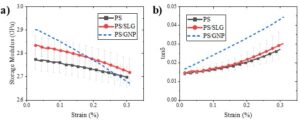 Despite this potential, existing state of knowledge about the damping behavior of graphene reinforced nanocomposites is at an embryonic stage. In particular, it is not clear how various morphological parameters of graphene contribute to damping. We aim to reveal the mechanical damping behavior of graphene-reinforced polymer nanocomposites as a function of the surface morphology of graphene nanoplatelets through combined experiments and continuum modeling. The vibrational damping behavior of graphene nanocomposites was studied via dynamic mechanical analysis via cycling tension-compression tests. Two graphene types, “single-layer graphene” (SLG) and “graphene nanoplatelets” (GNP), with different aspect ratios in polystyrene (PS) matrix were used. We developed a micromechanical model which relates damping in nanocomposites to filler-matrix frictional sliding. The experimental work demonstrated that the addition of GNP will increase the damping properties of the nanocomposites by up to ~70%. The model predictions for PS-GNP were in good agreement with experimental data. However, contrary to the model predictions, the damping coefficient of nanocomposites with lower aspect ratio particles (PS-SLG) was lower than PS-GNP. Further experimental studies showed that the surface roughness of the SLG (owed to their small thickness) has a negative effect on damping properties as they delay interfacial debonding and frictional sliding. Flat (less rough) graphene triggers intrinsic friction mechanism earlier and may be more beneficial to enhance damping. Surface undulation of the nanoparticles, which can happen for atomically thin particles, will delay damping.
Despite this potential, existing state of knowledge about the damping behavior of graphene reinforced nanocomposites is at an embryonic stage. In particular, it is not clear how various morphological parameters of graphene contribute to damping. We aim to reveal the mechanical damping behavior of graphene-reinforced polymer nanocomposites as a function of the surface morphology of graphene nanoplatelets through combined experiments and continuum modeling. The vibrational damping behavior of graphene nanocomposites was studied via dynamic mechanical analysis via cycling tension-compression tests. Two graphene types, “single-layer graphene” (SLG) and “graphene nanoplatelets” (GNP), with different aspect ratios in polystyrene (PS) matrix were used. We developed a micromechanical model which relates damping in nanocomposites to filler-matrix frictional sliding. The experimental work demonstrated that the addition of GNP will increase the damping properties of the nanocomposites by up to ~70%. The model predictions for PS-GNP were in good agreement with experimental data. However, contrary to the model predictions, the damping coefficient of nanocomposites with lower aspect ratio particles (PS-SLG) was lower than PS-GNP. Further experimental studies showed that the surface roughness of the SLG (owed to their small thickness) has a negative effect on damping properties as they delay interfacial debonding and frictional sliding. Flat (less rough) graphene triggers intrinsic friction mechanism earlier and may be more beneficial to enhance damping. Surface undulation of the nanoparticles, which can happen for atomically thin particles, will delay damping.
-
“Porous nitrogen-doped MXene-based electrodes for capacitive deionization” Energy Storage Materials Volume 25, March 2020, Pages 731-739
A facile and novel process is proposed and demonstrated to fabricate highly-porous nitrogen-doped MXene sheets (N–Ti3C2Tx) with great promise for seawater desalination.
 The nitrogen-doping is used to form a framework with open pore structures (total pore volume of 0.84 cm3 g−1) and high specific surface area (368.8 m2 g−1), simultaneously to hinder the restacking of MXenes layers and to improve electrical conductivity. The processed N–Ti3C2Tx shows promising volumetric capacitance (514 F cm−3) and represents tremendous electrochemical stability maintaining 99.75% of the initial volumetric capacitance after 2,000 cycles in 1 M sodium chloride electrolyte. We showed that nitrogen-doped MXene sheet is a high-potential electrode material for capacitive deionization (CDI) application, which outperforms all the recently reported materials by considering a combination of two efficient characteristics: electroadsorption rate and capacitance. The N–Ti3C2Tx shows stable performance over 24 CDI cycles with an average salt adsorption capacity of 117 ± 4.7 mg cm−3 (43.5 ± 1.7 mg g−1) in 5,000 mg/L NaCl solution (applied voltage of 1.2 V).
The nitrogen-doping is used to form a framework with open pore structures (total pore volume of 0.84 cm3 g−1) and high specific surface area (368.8 m2 g−1), simultaneously to hinder the restacking of MXenes layers and to improve electrical conductivity. The processed N–Ti3C2Tx shows promising volumetric capacitance (514 F cm−3) and represents tremendous electrochemical stability maintaining 99.75% of the initial volumetric capacitance after 2,000 cycles in 1 M sodium chloride electrolyte. We showed that nitrogen-doped MXene sheet is a high-potential electrode material for capacitive deionization (CDI) application, which outperforms all the recently reported materials by considering a combination of two efficient characteristics: electroadsorption rate and capacitance. The N–Ti3C2Tx shows stable performance over 24 CDI cycles with an average salt adsorption capacity of 117 ± 4.7 mg cm−3 (43.5 ± 1.7 mg g−1) in 5,000 mg/L NaCl solution (applied voltage of 1.2 V).
-
“Formation of wavy carbon nanofibers and nanocoils via precursor constrained microbuckling” Journal of the Mechanics and Physics of Solids, Volume 134, January 2020, 103763
Flexible carbon nanosprings and wavy nanofibers can be used in micro and nanoelectromechanical system devices, deployable structures, flexible displays, energy storage, catalysis, nanocomposites and a multitude of other uses.
 A novel method to produce wavy and helical carbon nanofibers (CNFs) is presented here. The CNFs with controlled geometry were fabricated via pyrolysis of electrospun polyacrylonitrile (PAN) nanofibers as the precursor. The waviness/helicity of nanofibers was achieved by subjecting the precursor nanofibers to constraint buckling inside a thermally shrinking matrix. The much higher tendency of the matrix to shrink, compared to PAN nanofibers, was achieved by controlling the microstructure and crystallinity of the precursors. The formation of the wavy/helical geometry was explained quantitatively via mechanistic models, by minimizing the total mechanical energy stored in the PAN-matrix system during the matrix shrinkage. Despite its simplicity in considering elastic deformations only, the model provided reasonably quantitative matching with the experiments. Compared to existing methods in generating wavy/helical nanofibers, such as chemical vapor deposition growth methods, our method provides a more controllable geometry which is suitable for large scale production of aligned buckled CNFs.
A novel method to produce wavy and helical carbon nanofibers (CNFs) is presented here. The CNFs with controlled geometry were fabricated via pyrolysis of electrospun polyacrylonitrile (PAN) nanofibers as the precursor. The waviness/helicity of nanofibers was achieved by subjecting the precursor nanofibers to constraint buckling inside a thermally shrinking matrix. The much higher tendency of the matrix to shrink, compared to PAN nanofibers, was achieved by controlling the microstructure and crystallinity of the precursors. The formation of the wavy/helical geometry was explained quantitatively via mechanistic models, by minimizing the total mechanical energy stored in the PAN-matrix system during the matrix shrinkage. Despite its simplicity in considering elastic deformations only, the model provided reasonably quantitative matching with the experiments. Compared to existing methods in generating wavy/helical nanofibers, such as chemical vapor deposition growth methods, our method provides a more controllable geometry which is suitable for large scale production of aligned buckled CNFs.2019
-
“Wire Melt Electrospun Polymer Nanocomposite Fibers as Radio Frequency Responsive Heaters” ACS Appl. Polym. Mater. 2019, 1, 10, 2751–2759
We have demonstrated noncontact heating of melt electrospun polymer fibers by using radio-frequency (RF) fields which heat carbon nanotube (CNT) receptors inside the fibers.
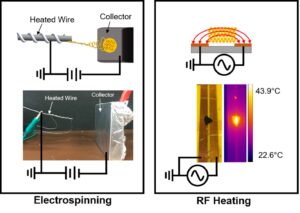 RF radiation is attractive as it allows for noncontact heating of polymers with low concentrations of CNTs. We observed that the heating rate scales with the CNT loading even below the bulk electrical percolation threshold, suggesting that individual CNTs can serve as RF receptors/heat sources. This capability eliminates the requirement for a percolated network of CNTs inside a fiber as a means to enable heating. We also showed that a strong radial temperature gradient will develop within the fibers. For a 2 μm diameter fiber, the temperature of the core is 10–15 °C higher than the surface. Hence, the temperature of the core can surpass the melting temperature inside the fiber without altering the morphology of the fibers (i.e., without fusing between fibers). These electrospun fibers that can be stimulated through RF energy can be used for applications such as plastic electric heaters, hyperthermia treatment, and heat-generating textiles.
RF radiation is attractive as it allows for noncontact heating of polymers with low concentrations of CNTs. We observed that the heating rate scales with the CNT loading even below the bulk electrical percolation threshold, suggesting that individual CNTs can serve as RF receptors/heat sources. This capability eliminates the requirement for a percolated network of CNTs inside a fiber as a means to enable heating. We also showed that a strong radial temperature gradient will develop within the fibers. For a 2 μm diameter fiber, the temperature of the core is 10–15 °C higher than the surface. Hence, the temperature of the core can surpass the melting temperature inside the fiber without altering the morphology of the fibers (i.e., without fusing between fibers). These electrospun fibers that can be stimulated through RF energy can be used for applications such as plastic electric heaters, hyperthermia treatment, and heat-generating textiles.
-
“Promising Trade‐Offs Between Energy Storage and Load Bearing in Carbon Nanofibers as Structural Energy Storage Devices” Adv. Funct. Mater. 2019, 29, 1901425
Structural energy storage materials refer to a broad category of multifunctional materials which can simultaneously provide load bearing and energy storage to achieve weight reduction in weight‐sensitive applications.
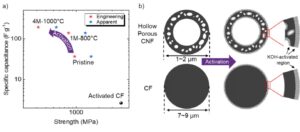 Reliable and satisfactory performance in each function, load bearing or energy storage, requires peculiar material design with potential trade‐offs between them. Here, the trade‐offs between functionalities in an emerging class of nanomaterials, carbon nanofibers (CNFs), are unraveled. The CNFs are fabricated by emulsion and coaxial electrospinning and activated by KOH at different activation conditions. The effect of activation on supercapacitor performance is analyzed using two electrode test cells with aqueous electrolyte. Porous CNFs show promising energy storage capacity (191.3 F g−1 and excellent cyclic stability) and load‐bearing capability (σf > 0.55 ± 0.15 GPa and E > 27.4 ± 2.6 GPa). While activation enhances surface area and capacitance, it introduces flaws in the material, such as nanopores, reducing mechanical properties. It is found that moderate activation can lead to dramatic improvement in capacitance (by >300%), at a rather moderate loss in strength (<17%). The gain in specific surface area and capacitance in CNFs is many times those observed in bulk carbon structures, such as carbon fibers, indicating that activation is mainly effective near the free surfaces and for low‐dimensional materials.
Reliable and satisfactory performance in each function, load bearing or energy storage, requires peculiar material design with potential trade‐offs between them. Here, the trade‐offs between functionalities in an emerging class of nanomaterials, carbon nanofibers (CNFs), are unraveled. The CNFs are fabricated by emulsion and coaxial electrospinning and activated by KOH at different activation conditions. The effect of activation on supercapacitor performance is analyzed using two electrode test cells with aqueous electrolyte. Porous CNFs show promising energy storage capacity (191.3 F g−1 and excellent cyclic stability) and load‐bearing capability (σf > 0.55 ± 0.15 GPa and E > 27.4 ± 2.6 GPa). While activation enhances surface area and capacitance, it introduces flaws in the material, such as nanopores, reducing mechanical properties. It is found that moderate activation can lead to dramatic improvement in capacitance (by >300%), at a rather moderate loss in strength (<17%). The gain in specific surface area and capacitance in CNFs is many times those observed in bulk carbon structures, such as carbon fibers, indicating that activation is mainly effective near the free surfaces and for low‐dimensional materials.
-
“Mechanical size effects of amorphous polymer-derived ceramics at the nanoscale: experiments and ReaxFF simulations” Nanoscale, 15, 2019
Here we report an unprecedented mechanical size effect at the nanoscale in polymer-derived ceramic (PDC) nanofibers.
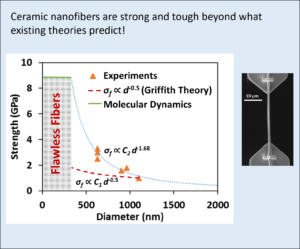 Silicon oxycarbide (SiOC) PDCs were fabricated as micro- and nanofibers without the aid of fillers. By decreasing the size of SiOC ceramic fibers from 1.1 μm to 630 nm (reduction of 74%), the strength of nanofibers nearly tripled, going from ∼1 GPa to ∼3.3 GPa. This increase in strength exceeds the predictions of the Griffith theorem, which relies on the length-scale dependence of energy release rate during crack propagation, suggesting a reduction in flaw size more than proportional to sample size. Given the crosslinked and amorphous nature of SiOC PDCs, flaws are likely microcracks and voids, which form during polymer degassing as it is pyrolyzed to PDC nanofibers. A reduction in sample size may favor degassing via diffusion, preceding bubble and void formation. We developed a new reactive force field (ReaxFF) with parameters for Si/O/C/H/N to study the mechanics of PDCs in extreme cases where no void is present. The models and experiments compare favorably in terms of the elastic modulus. The simulations suggest a strength of ∼8.5 GPa for a “flawless” structure, which is in line with extrapolated experimental results, with C–C breakage as the root cause of failure. This work clearly shows the benefits of utilizing nanoscale components as building blocks of superstrong PDC structures.
Silicon oxycarbide (SiOC) PDCs were fabricated as micro- and nanofibers without the aid of fillers. By decreasing the size of SiOC ceramic fibers from 1.1 μm to 630 nm (reduction of 74%), the strength of nanofibers nearly tripled, going from ∼1 GPa to ∼3.3 GPa. This increase in strength exceeds the predictions of the Griffith theorem, which relies on the length-scale dependence of energy release rate during crack propagation, suggesting a reduction in flaw size more than proportional to sample size. Given the crosslinked and amorphous nature of SiOC PDCs, flaws are likely microcracks and voids, which form during polymer degassing as it is pyrolyzed to PDC nanofibers. A reduction in sample size may favor degassing via diffusion, preceding bubble and void formation. We developed a new reactive force field (ReaxFF) with parameters for Si/O/C/H/N to study the mechanics of PDCs in extreme cases where no void is present. The models and experiments compare favorably in terms of the elastic modulus. The simulations suggest a strength of ∼8.5 GPa for a “flawless” structure, which is in line with extrapolated experimental results, with C–C breakage as the root cause of failure. This work clearly shows the benefits of utilizing nanoscale components as building blocks of superstrong PDC structures.
-
“Wire Melt Electrospinning of Thin Polymeric Fibers via Strong Electrostatic Field Gradients” Macromol. Mater. Eng. 2018, 1800417.
Here, a novel melt electrospinning method to produce few‐micron and nanometer thick fibers is presented, in which a polymer‐coated wire with a sharp tip is used as the polymer source.
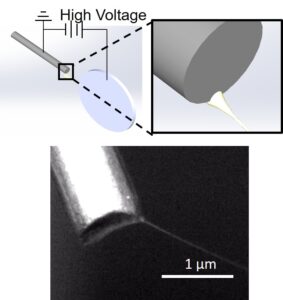 The polymer coating is melted via Joule heating of the source wire and extracted toward the target via electrostatic forces. The high viscosity and low charge density of polymer melts lower their stretchability in melt. The method relies on confining the Taylor cone and reducing initial jet diameter via concentrated electrostatic fields as a means to reduce the diameter of fibers. As a result, the initial jet diameter and the final fiber diameter are reduced by an order of magnitude of three to ten times, respectively, using wire melt electrospinning compared to syringe‐ and edge‐based electrospinning. The fiber diameter melt electrospun via this novel method is 1.0 ± 0.9 µm, considerably thinner than conventional melt electrospinning techniques. The generation of thin fibers are explained in terms of the electrostatic field around the wire tip, as obtained from finite element analysis (FEA), which controls the size and shape of the melt electrospun jet.
The polymer coating is melted via Joule heating of the source wire and extracted toward the target via electrostatic forces. The high viscosity and low charge density of polymer melts lower their stretchability in melt. The method relies on confining the Taylor cone and reducing initial jet diameter via concentrated electrostatic fields as a means to reduce the diameter of fibers. As a result, the initial jet diameter and the final fiber diameter are reduced by an order of magnitude of three to ten times, respectively, using wire melt electrospinning compared to syringe‐ and edge‐based electrospinning. The fiber diameter melt electrospun via this novel method is 1.0 ± 0.9 µm, considerably thinner than conventional melt electrospinning techniques. The generation of thin fibers are explained in terms of the electrostatic field around the wire tip, as obtained from finite element analysis (FEA), which controls the size and shape of the melt electrospun jet.
-
“The formation of highly ordered graphitic interphase around embedded CNTs controls the mechanics of ultra-strong carbonized nanofibers”, Acta Materialia, Volume 162, 1 January 2019, Pages 46-54
Templating graphitization, i.e., the transformation of certain polymers to highly-ordered graphitic (HOG) domains upon pyrolysis in the vicinity of graphitic nanomaterials, such as carbon nanotubes (CNTs), is known to be an effective approach to modify the microstructure of carbon nanofibers (CNFs).
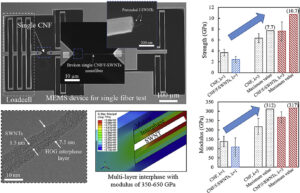 In this work, the microstructure of CNFs subjected to the templating effect of functionalized single-walled CNTs (f-SWNTs) and the effect of templating on mechanical properties of CNF/f-SWNTs hybrid nanofiber are studied. The CNF/f-SWNTs were fabricated via pyrolysis of electrospun polyacrylonitrile precursors with CNT inclusions. Prior to pyrolysis, the precursors were subjected to thermomechanical treatments, known as hot-drawing, to enhance chain and CNT alignment and packing. The study of the microstructure of the precursor and CNFs indicates the crucial role of precursor hot-drawing in enhancing the microstructure of the precursor and CNFs, leading to drastically enhanced templating effect, as evidenced from the thickness of the HOG that forms around CNTs. Mechanical tests on single nanofibers using custom-designed microdevices led to the realization that the templating effect of CNTs on CNFs, when properly implemented via precursor hot-drawing, can considerably increase the strength of CNFs. The average tensile strength and modulus of CNF/f-SWNTs in which HOG domains had clearly formed were measured to be 7.6 and 268 GPa, respectively, which are the highest value reported to date among similar types of materials. The existence and evolution of the HOG around CNTs inside CNFs and mechanical reinforcing of HOG were thoroughly discussed in conjunction with finite element models of building blocks of CNFs, alluding to the stress fields around HOG and CNTs in the CNF. The high-performance 1-D hybrid graphitic nanostructure developed here, CNF/f-SWNTs, can serve as an outstanding reinforcement material for weight sensitive applications.
In this work, the microstructure of CNFs subjected to the templating effect of functionalized single-walled CNTs (f-SWNTs) and the effect of templating on mechanical properties of CNF/f-SWNTs hybrid nanofiber are studied. The CNF/f-SWNTs were fabricated via pyrolysis of electrospun polyacrylonitrile precursors with CNT inclusions. Prior to pyrolysis, the precursors were subjected to thermomechanical treatments, known as hot-drawing, to enhance chain and CNT alignment and packing. The study of the microstructure of the precursor and CNFs indicates the crucial role of precursor hot-drawing in enhancing the microstructure of the precursor and CNFs, leading to drastically enhanced templating effect, as evidenced from the thickness of the HOG that forms around CNTs. Mechanical tests on single nanofibers using custom-designed microdevices led to the realization that the templating effect of CNTs on CNFs, when properly implemented via precursor hot-drawing, can considerably increase the strength of CNFs. The average tensile strength and modulus of CNF/f-SWNTs in which HOG domains had clearly formed were measured to be 7.6 and 268 GPa, respectively, which are the highest value reported to date among similar types of materials. The existence and evolution of the HOG around CNTs inside CNFs and mechanical reinforcing of HOG were thoroughly discussed in conjunction with finite element models of building blocks of CNFs, alluding to the stress fields around HOG and CNTs in the CNF. The high-performance 1-D hybrid graphitic nanostructure developed here, CNF/f-SWNTs, can serve as an outstanding reinforcement material for weight sensitive applications.
2018
-
“Mechanics of Emulsion Electrospun Porous Carbon Fibers as Building Blocks of Multifunctional Materials” ,ACS Appl. Mater. Interfaces 2018, 10, 44, 38310–38318
Many multifunctional composite structures incorporate porosity at various length scales to increase the available surface area of a functional component. One material system of particular interest is activated or porous carbon fibers and nanofibers that can serve as structural reinforcement as well as providing active surface for added functionality.
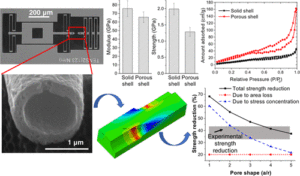 A key question in the design and manufacture of these fibers is to what degree the induced pore affects the mechanical properties by inducing discontinuities in the material. To address this problem, mechanics of porous carbon nanofibers (CNFs) was studied for the first time as a function of their porous structure. Hollow CNF with porous shell was prepared by coaxial electrospinning a polyacrylonitrile/poly(methyl methacrylate) (PMMA) blend shell with a PMMA core. PMMA was removed by thermal decomposition during pyrolysis to form pores. Solid-shell CNF was prepared as a control with no PMMA in the shell. Results show that the modulus and strength of the porous-shell CNF with a porosity of 19.2 ± 1.3% were 65.0 ± 6.2 and 1.28 ± 0.14 GPa respectively, 13.9 ± 2.1% and 35.5 ± 4.9% lower than those of the solid-shell CNF. Finite-element analysis models were developed to decouple the effect of stress concentration and reduced load-bearing area in porous CNFs on their mechanical properties. The model predictions were in general agreement with the experimental results and were used to identify the most critical parameters that can affect load bearing in porous nanofibers. Considering the comparison of the experimental and modeling results, the intrinsic material strength (of the solid parts) does not seem to be affected by inducing pores; thus, fiber and pore geometries might be developed where the load paths are designed for even less of a strength loss.
A key question in the design and manufacture of these fibers is to what degree the induced pore affects the mechanical properties by inducing discontinuities in the material. To address this problem, mechanics of porous carbon nanofibers (CNFs) was studied for the first time as a function of their porous structure. Hollow CNF with porous shell was prepared by coaxial electrospinning a polyacrylonitrile/poly(methyl methacrylate) (PMMA) blend shell with a PMMA core. PMMA was removed by thermal decomposition during pyrolysis to form pores. Solid-shell CNF was prepared as a control with no PMMA in the shell. Results show that the modulus and strength of the porous-shell CNF with a porosity of 19.2 ± 1.3% were 65.0 ± 6.2 and 1.28 ± 0.14 GPa respectively, 13.9 ± 2.1% and 35.5 ± 4.9% lower than those of the solid-shell CNF. Finite-element analysis models were developed to decouple the effect of stress concentration and reduced load-bearing area in porous CNFs on their mechanical properties. The model predictions were in general agreement with the experimental results and were used to identify the most critical parameters that can affect load bearing in porous nanofibers. Considering the comparison of the experimental and modeling results, the intrinsic material strength (of the solid parts) does not seem to be affected by inducing pores; thus, fiber and pore geometries might be developed where the load paths are designed for even less of a strength loss. -
“Non-intertwined graphitic domains leads to super strong and tough continuous 1D nanostructures”, Carbon Volume 137, October 2018, Pages 242-251
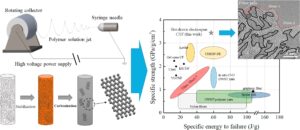
A systematic study on mechanics of carbon nanofibers (CNF) in relation to their microstructure is presented. The CNFs were fabricated via pyrolysis of polymeric nanofibers. In order to develop super-strong and super-tough one-dimensional nanomaterials, processing steps were aimed at reducing defects, e.g., poor graphitic alignment. The degree of graphitization was optimally controlled to benefit from strong sp2 C-C bonds while avoiding strength-compromising interactions between graphitic domains. The peculiar feature in CNFs was the discontinuity and rather uniform dispersion of turbostratic domains within the amorphous carbon, an apparent cause of crack pinning, and crack path deflection, thus strengthening/toughening. Hence, our CNFs exhibited superior strength compared to other emerging high-performance continuous fibers, such as CNT and graphene fibers. The best processing condition led to record high average strength of 6.3 ± 0.8 GPa (7.7 GPa maximum), 66% higher than previous reports. Moreover and contrary to most engineering materials, the high strength was achieved at no cost to ductility. The CNF exhibited significant ductility of 3.0 ± 0.7%, with energy-to-failure as high as 86 J/g, the highest reported for graphitic fibers. The research on simultaneously strong and tough CNF provides a promising pathway to develop the next generation of nanoscale reinforcements for lightweight and safety-critical structural applications.
-
“Recent advances in scalable production of pure graphene, wrinkled, crumpled and functionalized graphene: A promising comprehensive review of liquid-phase methods and challenges.” FlatChem Volume 8, March 2018, Pages 40-71
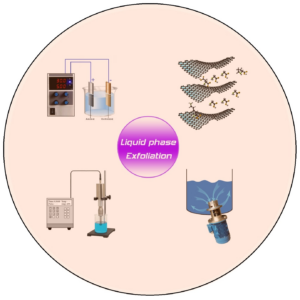
Graphene, the 2D form of carbon-based material existing as a single layer of atoms arranged in a honeycomb lattice has set the science and technology sectors alight with interest in the last decade in view of its astounding electrical and thermal properties, combined with its mechanical stiffness, strength and elasticity. Mass production of graphene is prerequisite for its viability and wide applications. The liquid-phase exfoliation of graphite into graphene is one of the most promising ways to achieve large-scale production at an extremely low cost. Another related main challenge is to find an economical procedure for large scale production of functionalized single- and few-layered graphene sheets. This review focuses on discussing different liquid-phase exfoliation methods based on a common mechanical mechanism. It is our premise that a deep understanding of the exfoliation mechanism can provide fruitful information on how to efficiently achieve high-quality graphene by optimizing exfoliation techniques. We highlight the recent progress on liquid-phase exfoliation for graphene production during the last decade. The emphasis is set on the widely used direct ultrasonic exfoliation methods, stabilizer-based exfoliation procedures, the newly explored wet-ball milling methods, shear exfoliation approaches, functionalization-assisted exfoliation techniques, electrochemical exfoliation routes, and the innovative supercritical fluid approaches. Various synthetic approaches are categorized and the advantages and disadvantages of different liquid-phase exfoliation methods are described. In addition, the main concerns regarding the quality and structure of the graphene sheet produced from aforementioned methods and the importance of a comprehensive evaluation of the final bulk graphene materials will also be discussed. We hope this review will point towards a rational direction for the scalable production of graphene.
-
“Interfused Nanofibers Network in Scalable Manufacturing of Polymeric Fibers via Multi-Nozzle Electrospinning“, Micro and Nanoletters, Volume 13, Issue 4, April 2018, p. 536 – 540
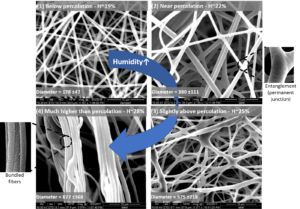
We have studied the formation of interfused network of nanofibers in multiple needle electrospinning, a phenomenon reported for the first time to our knowledge. Our study points to the significant role of humidity in controlling the morphology of nanofiber ensemble in electrospinning: when the humidity is sufficiently low, entangled mat of nanofibers with little or no interfusion between them are formed. However, at sufficiently high humidity, electrospun jets diffused into each other, forming a network of interfused fibers. The onset of jet interfusion during electrospinning is noticeable with naked eyes. The humidity that corresponds to the onset of the jet interfusion is referred to as the humidity threshold. We studied the formation of the nanofiber interfusion, and the relationships between humidity threshold and nanofiber diameters with processing parameters. We then presented a theory which explains the formation of the interfused network of fibers in terms of water condensation on the jets due to evaporative cooling. The presented approach allows for direct (one-step) fabrication of high surface area nanofiber network without post processing. This unique fiber structure can have significant implications on fiber applications for air and water filtering, where structural integrity of the filter matters.
-
“Carbon nanotubes within Polymer Matrix can Synergistically Enhance Mechanical Energy Dissipation.” Nanotechnology, Volume 29, Number 11, 2018
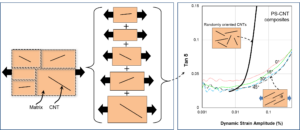 Safe operation and health of structures relies on their ability to effectively dissipate undesired vibrations, which could otherwise significantly reduce the life-time of a structure due to fatigue loads or large deformations. To address this issue, nanoscale fillers, such as carbon nanotubes (CNTs), have been utilized to dissipate mechanical energy in polymer-based nanocomposites through filler-matrix interfacial friction by benefitting from their large interface area with the matrix. In this manuscript, for the first time, we experimentally investigate the effect of CNT alignment with respect to reach other and their orientation with respect to the loading direction on vibrational damping in nanocomposites. The matrix was polystyrene (PS). A new technique was developed to fabricate PS-CNT nanocomposites which allows for controlling the angle of CNTs with respect to the far-field loading direction (misalignment angle). Samples were subjected to dynamic mechanical analysis, and the damping of the samples were measured as the ratio of the loss to storage moduli vs. CNT misalignment angle. Our results defied a notion that randomly oriented CNT nanocomposites can be approximated as a combination of matrix-CNT volume elements with randomly aligned CNTs. Instead, our results points to major contributions of induced stress concentration by each CNT in the matrix in proximity of other CNTs on vibrational damping. The stress fields around CNTs in PS-CNT nanocomposites were studied via finite element analysis. Our findings provide significant new insights not only on vibrational damping nanocomposites, but also on their failure modes and toughness, in relation to interface phenomena.
Safe operation and health of structures relies on their ability to effectively dissipate undesired vibrations, which could otherwise significantly reduce the life-time of a structure due to fatigue loads or large deformations. To address this issue, nanoscale fillers, such as carbon nanotubes (CNTs), have been utilized to dissipate mechanical energy in polymer-based nanocomposites through filler-matrix interfacial friction by benefitting from their large interface area with the matrix. In this manuscript, for the first time, we experimentally investigate the effect of CNT alignment with respect to reach other and their orientation with respect to the loading direction on vibrational damping in nanocomposites. The matrix was polystyrene (PS). A new technique was developed to fabricate PS-CNT nanocomposites which allows for controlling the angle of CNTs with respect to the far-field loading direction (misalignment angle). Samples were subjected to dynamic mechanical analysis, and the damping of the samples were measured as the ratio of the loss to storage moduli vs. CNT misalignment angle. Our results defied a notion that randomly oriented CNT nanocomposites can be approximated as a combination of matrix-CNT volume elements with randomly aligned CNTs. Instead, our results points to major contributions of induced stress concentration by each CNT in the matrix in proximity of other CNTs on vibrational damping. The stress fields around CNTs in PS-CNT nanocomposites were studied via finite element analysis. Our findings provide significant new insights not only on vibrational damping nanocomposites, but also on their failure modes and toughness, in relation to interface phenomena.
2017
-
Chen Y., Boyd J., and Naraghi M., “Porous Fibers with Encapsulated Functional Materials and Tunable Release as a Platform to Develop Versatile Multifunctional Textiles”, Journal of Microencapsulation, in press, 2017. (2017).
A novel sequential processing approach to fabricate versatile fibres containing encapsulated materials is presented. It is based on developing highly porous fibres, to be filled with functional materials and coated with protective layers.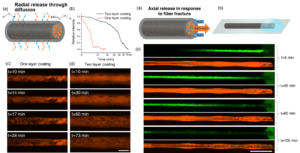 Applicability of the approach to develop porous poly(methyl methacrylate) (PMMA) fibres with encapsulated antibacterial salts within a coating is demonstrated. The salt was introduced to the fibre via a sacrificial solvent. Desired solvent properties to ensure successful filling was discussed. The salt was encapsulated via spray coating. The coating characteristics were tuned via vapour treatment to facilitate controllable radial salt release. Large volume axial release was also achieved due to the axial pore connectivity. Compared to state-of-the-art methods to produce fibres with functional material inclusions such as emulsion electrospinning, the method presented herein, due to its sequential processing nature, offers greater freedom in material selection and thus broad applications of the fibres.
Applicability of the approach to develop porous poly(methyl methacrylate) (PMMA) fibres with encapsulated antibacterial salts within a coating is demonstrated. The salt was introduced to the fibre via a sacrificial solvent. Desired solvent properties to ensure successful filling was discussed. The salt was encapsulated via spray coating. The coating characteristics were tuned via vapour treatment to facilitate controllable radial salt release. Large volume axial release was also achieved due to the axial pore connectivity. Compared to state-of-the-art methods to produce fibres with functional material inclusions such as emulsion electrospinning, the method presented herein, due to its sequential processing nature, offers greater freedom in material selection and thus broad applications of the fibres.
-
Mayadeo N., Morikawa K., Naraghi M., and Green M., “Modeling of downstream heating in melt electrospinning of polymers”, Journal of Polymer Physics Part B: Polymer Physics, 55, 1393-1405 (2017).
In this study, both modeling and experimental approaches are used to demonstrate that downstream volumetric heating of electrospun fibers during melt electrospinning can result in markedly decreased fiber diameters.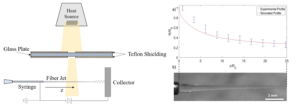 Previous melt electrospinning techniques were limited to production of micron-sized fibers. This is because high viscosity and low electrical conductivity of the polymer melt coupled with rapid heat loss to the surroundings resulted in solidification of the jet before it had been significantly stretched by the electric field. In our study, we utilize a model for non-isothermal melt electrospinning in the presence of a volumetric heat source. Our simulation results demonstrate that downstream heating does reduce the fiber diameter, and is therefore a feasible approach for resolving the limitations of melt electrospinning. In addition, our model has also been used to capture the effec t of the surrounding temperature, which affects the thinning of the fiber through surface rather than volumetric interactions. Finally, melt electrospinning experiments are utilized to validate the model predictions for downstream heating.
Previous melt electrospinning techniques were limited to production of micron-sized fibers. This is because high viscosity and low electrical conductivity of the polymer melt coupled with rapid heat loss to the surroundings resulted in solidification of the jet before it had been significantly stretched by the electric field. In our study, we utilize a model for non-isothermal melt electrospinning in the presence of a volumetric heat source. Our simulation results demonstrate that downstream heating does reduce the fiber diameter, and is therefore a feasible approach for resolving the limitations of melt electrospinning. In addition, our model has also been used to capture the effec t of the surrounding temperature, which affects the thinning of the fiber through surface rather than volumetric interactions. Finally, melt electrospinning experiments are utilized to validate the model predictions for downstream heating. -
Zou Y., Ji X., Cai J., Yuan T., Stanton D. J., Lin Y. H., Naraghi M. and Fang L., “Synthesis and Solution Processing of a Hydrogen-Bonded Ladder Polymer”, Chem, 2, 139-152 (2017).
Rigid coplanar ladder polymers equipped with regulated intermolecular interactions promise unique solid-state properties. Efficient synthesis and solution processing of these materials, however, are challenging because of their extremely poor solubility. Herein, we describe a
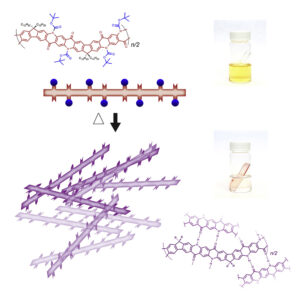 highly efficient, gram-scale synthesis of a hydrogen-bond-containing ladder polymer through an approach free of metal catalyst. The quinacridone-derived repeating unit features multiple self-complementary intermolecular hydrogen bonds along the rigid backbone. Using a reversible hydrogen-bond protection strategy, we were able to fully characterize this insoluble polymer in solution and process it into smooth thin films. In the solid state, the material demonstrated excellent resistance to organic solvents, aqueous acids, and thermal treatments, rendering a solution-processed, solvent-resistant thin film. This unique property allows for solution manipulation of robust polymer materials for applications associated with extreme operating or processing conditions. This scalable fused-ring polymer also demonstrated promising potential as a precursor for graphitic carbon materials.
highly efficient, gram-scale synthesis of a hydrogen-bond-containing ladder polymer through an approach free of metal catalyst. The quinacridone-derived repeating unit features multiple self-complementary intermolecular hydrogen bonds along the rigid backbone. Using a reversible hydrogen-bond protection strategy, we were able to fully characterize this insoluble polymer in solution and process it into smooth thin films. In the solid state, the material demonstrated excellent resistance to organic solvents, aqueous acids, and thermal treatments, rendering a solution-processed, solvent-resistant thin film. This unique property allows for solution manipulation of robust polymer materials for applications associated with extreme operating or processing conditions. This scalable fused-ring polymer also demonstrated promising potential as a precursor for graphitic carbon materials.
-
Chawla S., Cai J. and Naraghi M., “Mechanical tests on individual carbon nanofibers reveals the strong effect of graphitic alignment achieved via precursor hot-drawing”, Carbon, 117, 208-219 (2017).
PElectrospun carbon nanofibers (CNFs) processed via carbonization of electrospun precursors are an emerging class of nanoscale carbon-based materials with abundant sp2 CeC bonds which can offer significant opportunities for structural light-weighting in multifunctional materials. In this work, we have studied the effect of graphitic alignment on mechanical properties of CNFs. Graphitic alignment was achieved by hot-dra
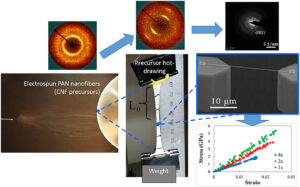 wing polyacrylonitrile (PAN) nanofiber precursors at temperatures above the Tg of PAN which induces chain alignment. We studied several states of PAN chain alignment by varying electrospinning take-up velocity and hot-drawing ratios. Chain alignment and orientation induced crystallization was studied via polarized Fourier Transform IR spectroscopy and X-ray diffraction. IR spectroscopy revealed that the formation of crystals delays thermal stabilization and cyclization in hotdrawn PAN nanofibers. Thus, we modified the stabilization process to transform PAN chains into a ladder-like structure suitable for carbonization. The carbonization was carried out at 1100 C. MEMSbased mechanical characterization of individual CNFs revealed over 100% improvement in average strength and over 70% improvement in modulus of CNFs as a result of graphitic alignment. The CNFs obtained from hot-drawn samples demonstrated strength as high as 5.4 GPa, which is among the highest reported for this class of material.
wing polyacrylonitrile (PAN) nanofiber precursors at temperatures above the Tg of PAN which induces chain alignment. We studied several states of PAN chain alignment by varying electrospinning take-up velocity and hot-drawing ratios. Chain alignment and orientation induced crystallization was studied via polarized Fourier Transform IR spectroscopy and X-ray diffraction. IR spectroscopy revealed that the formation of crystals delays thermal stabilization and cyclization in hotdrawn PAN nanofibers. Thus, we modified the stabilization process to transform PAN chains into a ladder-like structure suitable for carbonization. The carbonization was carried out at 1100 C. MEMSbased mechanical characterization of individual CNFs revealed over 100% improvement in average strength and over 70% improvement in modulus of CNFs as a result of graphitic alignment. The CNFs obtained from hot-drawn samples demonstrated strength as high as 5.4 GPa, which is among the highest reported for this class of material.
2016
-
Xu Z., Baniasadi M., Moreno S., Cai J., Naraghi M., and Minary-Jolandan M., “Evolution of electromechanical and morphological properties of piezoelectric thin films with thermomechanical processing”, Polymer, 106, 62-71 (2016).
Piezoelectric polymers (PVDF and its co-polymers) in film and nanofiber forms are increasingly used for sensing, actuation and energy harvesting. Given the semi-crystalline structure of these polymers, their electromechanical coupling behavior changes with thermomechanical processing. This article reports on the evolution of the mechanical properties, piezoelectric properties and morphology of P(VDF-TrFE) poly [(vinylidenef
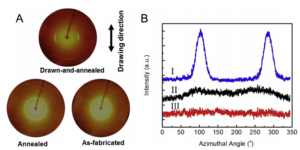 luoride)-co-trifluoroethylene] piezoelectric polymer thin films fabricated by spin-coating during thermal annealing and drawing, studied via tensile test, polarized optical microscopy, X-ray diffraction, polarized FTIR, and piezoresponse force microscopy (PFM). The results show that annealing and drawing pr
luoride)-co-trifluoroethylene] piezoelectric polymer thin films fabricated by spin-coating during thermal annealing and drawing, studied via tensile test, polarized optical microscopy, X-ray diffraction, polarized FTIR, and piezoresponse force microscopy (PFM). The results show that annealing and drawing pr
ocess result in ~10 and 13 folds improvement in the elastic modulus and strength of the films, respectively. In addition, the piezoelectric constant and electromechanical coupling improves by 30% and more than 17 times, respectively. These changes are accompanied by 65% increase in the percentage of the crystallinity of the semi-crystalline piezoelectric films, compared to the as-fabricated films.
-
Cai J., Chawla S., and Naraghi M., “Microstructural Evolution and Mechanics of Hot-drawn CNT-Reinforced Polymeric Nanofibers”, Carbon, 109, 813-822 (2016).
To unravel reinforcing effect of CNTs in polymeric nanofibers, polyacrylonitrile (PAN)/SWNTs nanofibers with various CNTs content (0.1–0.5 wt%) were electrospun. Nanofibers were hot-drawn to enhance PAN chains and SWNT alignment. The microstructure of composite nanofibers was studied via polarized Raman and IR spectroscopy, x-ray diffraction, and TEM imaging. The study pointed to a marked contribution of SWNTs at low SWNT contents (0.1 wt%) to chain mobility and alignment during electrospinning. Evidence of volume changes was reported during hot-drawing, depending on CNT content, alluding to arrangement of CNTs in nanofibers. Indirect evidence of SWNT a
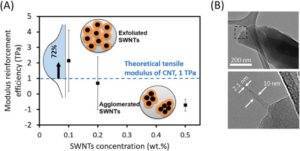 gglomeration, adversely affecting reinforcement efficiency at higher SWNT contents, was presented. Hot-drawing above Tg of PAN led to massive chain and SWNT alignment and orientation-induced crystallization. The most promising mechanical performance was achieved in hot-drawn ribbons with low SWNT content, where formation of an interphase –evidenced in TEM images – led to significant enhancement of effective reinforcement modulus of ∼2.15 ± 1.97 TPa, with the average value considerably higher than modulus of CNTs. This study demonstrates a clear path to prepare PAN nanofibers with high chain alignment as precursor for the next generation of carbon nanofibers with unprecedented strength and modulus.
gglomeration, adversely affecting reinforcement efficiency at higher SWNT contents, was presented. Hot-drawing above Tg of PAN led to massive chain and SWNT alignment and orientation-induced crystallization. The most promising mechanical performance was achieved in hot-drawn ribbons with low SWNT content, where formation of an interphase –evidenced in TEM images – led to significant enhancement of effective reinforcement modulus of ∼2.15 ± 1.97 TPa, with the average value considerably higher than modulus of CNTs. This study demonstrates a clear path to prepare PAN nanofibers with high chain alignment as precursor for the next generation of carbon nanofibers with unprecedented strength and modulus.
-
Gardea F., Glaz B., Riddick J., Lagoudas D., and Naraghi M., “Thermally Activated Energy Dissipation in Semi-crystalline Polymer Nanocomposites” Composites Science and Technology, 134, 275-286 (2016).
In this manuscript, we demonstrate the concept of active damping in semi-crystalline thermoplastics which are reinforced with a percolated network of CNTs, where the damping of the composite was augmented considerably, controllably and reversibly via Joule heating.
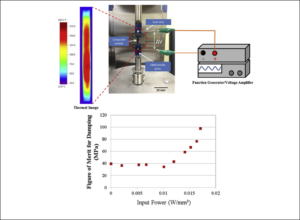 The Joule heating triggered relaxation mechanisms in the amorphous phase of the matrix. To this end, semi-crystalline poly ether ether ketone (PEEK) polymer and PEEK/carbon nanotube (CNT) composites were fabricated and their viscoelastic properties were studied. The damping performance was experimentally tested by dynamic mechanical analysis. The polymer relaxation resulting from an increase in temperature, triggered by the Joule heating of the nanoparticles, demonstrated the potential for damping enhancement in the composite. A considerable enhancement in damping (by as much as 400%) was achieved at a significantly lower relative loss in storage modulus (40%), both caused by relaxation mechanisms in Joule heated samples. This enhancement in damping corresponds to a 150% improvement in the figure of merit for damping materials. The non-uniform temperature distribution in the sample was measured experimentally at the macroscale and estimated via continuum models at the microscale. It was concluded that non-uniform temperature distribution in the composite, especially at the microscale, had a large effect on the overall damping enhancement. Based on the microscale models, potential mechanisms by which the active damping can be enhanced were discussed.
The Joule heating triggered relaxation mechanisms in the amorphous phase of the matrix. To this end, semi-crystalline poly ether ether ketone (PEEK) polymer and PEEK/carbon nanotube (CNT) composites were fabricated and their viscoelastic properties were studied. The damping performance was experimentally tested by dynamic mechanical analysis. The polymer relaxation resulting from an increase in temperature, triggered by the Joule heating of the nanoparticles, demonstrated the potential for damping enhancement in the composite. A considerable enhancement in damping (by as much as 400%) was achieved at a significantly lower relative loss in storage modulus (40%), both caused by relaxation mechanisms in Joule heated samples. This enhancement in damping corresponds to a 150% improvement in the figure of merit for damping materials. The non-uniform temperature distribution in the sample was measured experimentally at the macroscale and estimated via continuum models at the microscale. It was concluded that non-uniform temperature distribution in the composite, especially at the microscale, had a large effect on the overall damping enhancement. Based on the microscale models, potential mechanisms by which the active damping can be enhanced were discussed.Featured in https://advanceseng.com/,
-
Colbert K., Naraghi M. amd Boyd J.G., “An Experimentally Verified Model for Thermal Microactuators Including Nonlinear Material Properties, Radiation, and Intra-Device Heat Conduction”, Accepted , Journal of Micromechanics and Microengineering (2016).
This paper presents a model and computational method to predict the steady-state performance of thermal flexure microactuators at high input powers and various levels of partial vacuum.
 The model accounts for nonlinear temperature dependence of material properties, heat loss due to radiation, and intra-device heat transfer by conduction across an air gap. The model is validated by comparing the model predictions with the experimentally measured voltage, current, and displacement at standard conditions, prior to adjusting for partial vacuum. In order to understand the effect of nonlinearities on model reliability, the predictions of six additional hypothetical models are considered where (1) intra-device heat transfer is neglected, (2) radiation is neglected, (3) the thermal conductivity of silicon is assumed to be temperature-independent, (4) the thermal conductivity of air is assumed to be temperature-independent, (5) the electrical resistivity of silicon is assumed to be linear in temperature, and (6) the thermal expansion coefficient of silicon is assumed to be temperature-independent. All factors except radiation were shown to have a significant influence on the device performance especially at high input powers. The experimentally validated full model is then employed to predict the effect of reduced air pressure on the displacement and heat transfer properties of the actuator. This aspect of the study targets applications of thermal actuators in controlled environments such as space applications, actuators used for in situ micropositioning and tensile testing inside electron microscopy chambers, or actuators incorporated into the design of MEMS resonators. It was demonstrated that the maximum actuator displacement is not a linear function of reduced pressure and that it reaches a maximum at a certain partial vacuum level.
The model accounts for nonlinear temperature dependence of material properties, heat loss due to radiation, and intra-device heat transfer by conduction across an air gap. The model is validated by comparing the model predictions with the experimentally measured voltage, current, and displacement at standard conditions, prior to adjusting for partial vacuum. In order to understand the effect of nonlinearities on model reliability, the predictions of six additional hypothetical models are considered where (1) intra-device heat transfer is neglected, (2) radiation is neglected, (3) the thermal conductivity of silicon is assumed to be temperature-independent, (4) the thermal conductivity of air is assumed to be temperature-independent, (5) the electrical resistivity of silicon is assumed to be linear in temperature, and (6) the thermal expansion coefficient of silicon is assumed to be temperature-independent. All factors except radiation were shown to have a significant influence on the device performance especially at high input powers. The experimentally validated full model is then employed to predict the effect of reduced air pressure on the displacement and heat transfer properties of the actuator. This aspect of the study targets applications of thermal actuators in controlled environments such as space applications, actuators used for in situ micropositioning and tensile testing inside electron microscopy chambers, or actuators incorporated into the design of MEMS resonators. It was demonstrated that the maximum actuator displacement is not a linear function of reduced pressure and that it reaches a maximum at a certain partial vacuum level.
-
Sullivan E. M., Karimineghlani P, Naraghi M., Gerhardt R. A., Kalaitzidou K., “The effect of nanofiller geometry and compounding method on polylactic acid nanocomposite films”, European Polymer Journal, 77, 31-42 (2016).
The effect of the compounding method and of the nanofiller geometry on the thermo-mechanical properties and electrical behavior of polylactic acid (PLA) nanocomposite films was investigated. The films were fabricated using two methods: (i) melt compounding followed by melt fiber spinning or (
 ii) solution compounding followed by electrospinning. Both the melt and electrospun fibers were then compression molded. In the case of melt compounding, both exfoliated graphite nanoplatelets (GNP) and carbon nanotubes (CNT) were used as reinforcement, whereas only CNT were used in the case of solution compounding. The microstructure was examined using scanning electron microscopy and the crystallization behavior, thermo-mechanical behavior, and electrical response of the PLA composite films were investigated as a function of nanofiller content, geometry, and compounding method. It was concluded that the GNP/PLA films had the highest percolation at greater than 3 wt% of GNP, while the CNT/PLA films had the lowest at less than 1 wt% of CNT. In addition, the solution method and electrospun fibers resulted in a higher conductance compared to the CNT/PLA films of the same CNT content made by melt compounding due to a more heterogeneous distribution and dispersion of CNT throughout the matrix that facilitated the formation of interconnected conductive networks.
ii) solution compounding followed by electrospinning. Both the melt and electrospun fibers were then compression molded. In the case of melt compounding, both exfoliated graphite nanoplatelets (GNP) and carbon nanotubes (CNT) were used as reinforcement, whereas only CNT were used in the case of solution compounding. The microstructure was examined using scanning electron microscopy and the crystallization behavior, thermo-mechanical behavior, and electrical response of the PLA composite films were investigated as a function of nanofiller content, geometry, and compounding method. It was concluded that the GNP/PLA films had the highest percolation at greater than 3 wt% of GNP, while the CNT/PLA films had the lowest at less than 1 wt% of CNT. In addition, the solution method and electrospun fibers resulted in a higher conductance compared to the CNT/PLA films of the same CNT content made by melt compounding due to a more heterogeneous distribution and dispersion of CNT throughout the matrix that facilitated the formation of interconnected conductive networks.
-
Gardea F., Glaz B., Riddick J., Lagoudas D., and Naraghi M., “Identification of Energy Dissipation Mechanisms in CNT Reinforced Nanocomposites” Nanotechnology, 27(10), 105707 (2016).
In this paper we present our recent findings on the mechanisms of energy dissipation in polymerbased nanocomposites obtained through experimental investigations. The matrix of the nanocomposite was polystyrene (PS) which was reinforced with carbon nanotubes (CNTs). To study the mechanical strain energy d
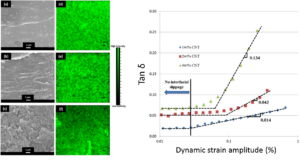 issipation of nanocomposites, we measured the ratio of loss to storage modulus for different CNT concentrations and alignments. CNT alignment was achieved via hot-drawing of PS-CNT. In addition, CNT agglomeration was studied via a combination of SEM imaging and Raman scanning. We found that at sufficiently low strains, energy dissipation in composites with high CNT alignment is not a function of applied strain, as no interfacial slip occurs between the CNTs and PS. However, below the interfacial slip strain threshold, damping scales monotonically with CNT content, which indicates the prevalence of CNT-CNT friction dissipation mechanisms within agglomerates. At higher strains, interfacial slip also contributes to energy dissipation. However, the increase in damping with strain, especially when CNT agglomerates are present, does not scale linearly with the effective interface area between CNTs and PS, suggesting a significant contribution of friction between CNTs within agglomerates to energy dissipation at large strains. In addition, for the first time, comparison between the energy dissipation in randomly oriented and aligned CNT composites was made. It is inferred that matrix plasticity and tearing caused by misorientation of CNTs with the loading direction is a major cause of energy dissipation. The results of our research can be used to design composites with high energy dissipation capability, especially for applications where dynamic loading may compromise structural stability and functionality, such as rotary wing structures and antennas.
issipation of nanocomposites, we measured the ratio of loss to storage modulus for different CNT concentrations and alignments. CNT alignment was achieved via hot-drawing of PS-CNT. In addition, CNT agglomeration was studied via a combination of SEM imaging and Raman scanning. We found that at sufficiently low strains, energy dissipation in composites with high CNT alignment is not a function of applied strain, as no interfacial slip occurs between the CNTs and PS. However, below the interfacial slip strain threshold, damping scales monotonically with CNT content, which indicates the prevalence of CNT-CNT friction dissipation mechanisms within agglomerates. At higher strains, interfacial slip also contributes to energy dissipation. However, the increase in damping with strain, especially when CNT agglomerates are present, does not scale linearly with the effective interface area between CNTs and PS, suggesting a significant contribution of friction between CNTs within agglomerates to energy dissipation at large strains. In addition, for the first time, comparison between the energy dissipation in randomly oriented and aligned CNT composites was made. It is inferred that matrix plasticity and tearing caused by misorientation of CNTs with the loading direction is a major cause of energy dissipation. The results of our research can be used to design composites with high energy dissipation capability, especially for applications where dynamic loading may compromise structural stability and functionality, such as rotary wing structures and antennas.
-
Baniasadi M., Xu Z., Hong S., Naraghi M. and Minary-Jolandan M., “Thermo-Electromechanical Behavior of Piezoelectric Nanofibers”, ACS Applied Materials and Interfaces, 8, 2540-2551 (2016).
High performance piezoelectric devices based on arrays of PVDF-TrFE nanofibers have been introduced in the literat
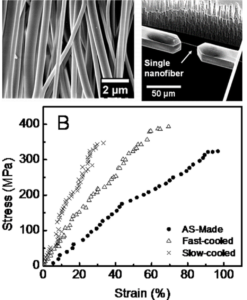 ure for a variety of applications including energy harvesting and sensing. In this Research Article, we utilize uniaxial tensile test on arrays of nanofibers, microtensile, and nanoindentation and piezo-response force microscopy (PFM) on individual nanofibers, as wells as DSC, XRD, and FTIR spectroscopy to investigate the effect of annealing on microstructure, mechanical, and piezoelectric properties of arrays and individual electrospun nanofibers. For PVDF-TrFE nanofibers annealing in a temperature between the Curie and melting temperature (in paraelectric phase) results in ∼70% increase in crystallinity of the nanofibers. The findings of our multiscale experiments reveal that this improvement in crystallinity results in ∼3-fold increase in elastic modulus, and ∼55% improvement in piezoelectric constant. Meanwhile, the ductility and tensile toughness of the nanofibers drop by ∼1 order of magnitude. In addition, nanoscale cracks were observed on the surface of the annealed nanofibers; however, they did not result in significant change in the strength of the nanofibers. The results of this work may have important implications for applications of PVDF-TrFE in energy harvesting, biomedical, and sensor areas.
ure for a variety of applications including energy harvesting and sensing. In this Research Article, we utilize uniaxial tensile test on arrays of nanofibers, microtensile, and nanoindentation and piezo-response force microscopy (PFM) on individual nanofibers, as wells as DSC, XRD, and FTIR spectroscopy to investigate the effect of annealing on microstructure, mechanical, and piezoelectric properties of arrays and individual electrospun nanofibers. For PVDF-TrFE nanofibers annealing in a temperature between the Curie and melting temperature (in paraelectric phase) results in ∼70% increase in crystallinity of the nanofibers. The findings of our multiscale experiments reveal that this improvement in crystallinity results in ∼3-fold increase in elastic modulus, and ∼55% improvement in piezoelectric constant. Meanwhile, the ductility and tensile toughness of the nanofibers drop by ∼1 order of magnitude. In addition, nanoscale cracks were observed on the surface of the annealed nanofibers; however, they did not result in significant change in the strength of the nanofibers. The results of this work may have important implications for applications of PVDF-TrFE in energy harvesting, biomedical, and sensor areas.
-
Cai J. and Naraghi M., “Computational Analysis of Electrical Conduction in Hybrid Nanomaterials with Embedded Non-penetrating Conductive Particles”, Modelling Simul. Mater. Sci. Eng. 24, 065004 (15pp) (2016).
In this work, a comprehensive multi-resolution two-dimensional (2D) resistor network model is proposed to analyze the electrical conductivity of hybrid nanomaterials made of insulating matrix with conductive particles such as CNT reinforced nanocomposites and thick film resistors. Unlike existing approaches, our mo
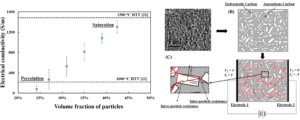 del takes into account the impenetrability of the particles and their random placement within the matrix. Moreover, our model presents a detailed description of intra-particle conductivity via finite element analysis, which to the authors’ best knowledge has not been addressed before. The inter-particle conductivity is assumed to be primarily due to electron tunneling. The model is then used to predict the electrical conductivity of electrospun carbon nanofibers as a function of microstructural parameters such as turbostratic domain alignment and aspect ratio. To simulate the microstructure of single CNF, randomly positioned nucleation sites were seeded and grown as turbostratic particles with anisotropic growth rates. Particle growth was in steps and growth of each particle in each direction was stopped upon contact with other particles. The study points to the significant contribution of both intra-particle and inter-particle conductivity to the overall conductivity of hybrid composites. Influence of particle alignment and anisotropic growth rate ratio on electrical conductivity is also discussed. The results show that partial alignment in contrast to complete alignment can result in maximum electrical conductivity of whole CNF. High degrees of alignment can adversely affect conductivity by lowering the probability of the formation of a conductive path. The results demonstrate approaches to enhance electrical conductivity of hybrid materials through controlling their microstructure which is applicable not only to carbon nanofibers, but also many other types of hybrid composites such as thick film resistors.
del takes into account the impenetrability of the particles and their random placement within the matrix. Moreover, our model presents a detailed description of intra-particle conductivity via finite element analysis, which to the authors’ best knowledge has not been addressed before. The inter-particle conductivity is assumed to be primarily due to electron tunneling. The model is then used to predict the electrical conductivity of electrospun carbon nanofibers as a function of microstructural parameters such as turbostratic domain alignment and aspect ratio. To simulate the microstructure of single CNF, randomly positioned nucleation sites were seeded and grown as turbostratic particles with anisotropic growth rates. Particle growth was in steps and growth of each particle in each direction was stopped upon contact with other particles. The study points to the significant contribution of both intra-particle and inter-particle conductivity to the overall conductivity of hybrid composites. Influence of particle alignment and anisotropic growth rate ratio on electrical conductivity is also discussed. The results show that partial alignment in contrast to complete alignment can result in maximum electrical conductivity of whole CNF. High degrees of alignment can adversely affect conductivity by lowering the probability of the formation of a conductive path. The results demonstrate approaches to enhance electrical conductivity of hybrid materials through controlling their microstructure which is applicable not only to carbon nanofibers, but also many other types of hybrid composites such as thick film resistors.
2015
-
Gardea F., Glaz B., Riddick J., Lagoudas D., and Naraghi M., “Energy Dissipation due to Interfacial Slip in Nanocomposites Reinforced with Aligned Carbon Nanotubes” ACS Applied Materials and Interfaces, 7, 9725-9735 (2015).
Interfacial slip mechanisms of strain energy dissipation and vibration damping of highly aligned carbon nanotube (CNT) reinforced polymer composites were studied through experimentation and complementary micromechanics modeling. Experimentally, we have developed CNT-polystyrene (PS) composites with a high deg
 ree of CNT alignment via a combination of twin-screw extrusion and hot-drawing. The aligned nanocomposites enabled a focused study of the interfacial slip mechanics associated with shear stress concentrations along the CNT-PS interface induced by the elastic mismatch between the filler and matrix. The variation of storage and loss modulus suggests the initiation of the interfacial slip occurs at axial strains as low as 0.028%, primarily due to shear stress concentration along the CNT-PS interface. Through micromechanics modeling and by matching the model with the experimental results at the onset of slip, the interfacial shear strength was evaluated. The model was then used to provide additional insight into the experimental observations by showing that the nonlinear variation of damping with dynamic strain can be attributed to slip-stick behavior. The dependence of the interfacial load-transfer reversibility on the dynamic strain history and characteristic time scale was experimentally investigated to demonstrate the relative contribution of van der Waals (vdW) interactions, mechanical interlocking, and covalent bonding to shear interactions.
ree of CNT alignment via a combination of twin-screw extrusion and hot-drawing. The aligned nanocomposites enabled a focused study of the interfacial slip mechanics associated with shear stress concentrations along the CNT-PS interface induced by the elastic mismatch between the filler and matrix. The variation of storage and loss modulus suggests the initiation of the interfacial slip occurs at axial strains as low as 0.028%, primarily due to shear stress concentration along the CNT-PS interface. Through micromechanics modeling and by matching the model with the experimental results at the onset of slip, the interfacial shear strength was evaluated. The model was then used to provide additional insight into the experimental observations by showing that the nonlinear variation of damping with dynamic strain can be attributed to slip-stick behavior. The dependence of the interfacial load-transfer reversibility on the dynamic strain history and characteristic time scale was experimentally investigated to demonstrate the relative contribution of van der Waals (vdW) interactions, mechanical interlocking, and covalent bonding to shear interactions.
-
Hong S., Minary-Jolandan M. and Naraghi, “Controlling the Wettability and Adhesion of Carbon Fibers with Polymer Interfaces via Grafted Nanofibers” Journal of Composites Science and Technology, 29, 130-138 (2015)
Interfacial properties in carbon fiber composites is one of the key parameters controlling their structural functionality. Here, we introduce a novel met
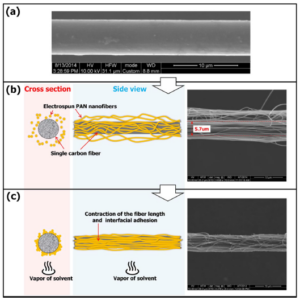 hod to engineer carbon fiber-epoxy interfaces, via inclusion of nanofibers, towards higher interfacial strength and energy dissipation. In our method, thermally stabilized polyacrylonitrile (PAN) nanofibers are grafted onto carbon fibers via electro-spinning process, followed by nanofiber consolidation via solvent vapor and thermal treatment. These treatments partially dissolves nanofibers along the nanofiber-fiber interface and trigger entropic elasticity in nanofibers, thus, increasing the nanofiber-fiber interactions. The hybridization of carbon fibers with PAN nanofibers increased the interfacial shear strength (IFSS) by ∼48%, from 10.8 ± 2.6 to 15.9 ± 4.9 MPa. Postmortem fractography points to mechanical interlocking between nanofibers and epoxy and reinforcing effects of nanofibers in matrix as root causes of IFSS enhancement. As a result of adding nanofibers to carbon fiber, junction failure mode changes from a dominantly adhesive failure (at epoxy-fiber interface) to dominantly cohesive failure, and failure plane slightly shifts away from epoxy-fiber interface to within the epoxy. Compared to other types of whiskers grown on carbon fibers, such as CNTs, the method proposed here requires low temperatures (below 300 °C), during which no surface damages are expected to accumulate on carbon fibers.
hod to engineer carbon fiber-epoxy interfaces, via inclusion of nanofibers, towards higher interfacial strength and energy dissipation. In our method, thermally stabilized polyacrylonitrile (PAN) nanofibers are grafted onto carbon fibers via electro-spinning process, followed by nanofiber consolidation via solvent vapor and thermal treatment. These treatments partially dissolves nanofibers along the nanofiber-fiber interface and trigger entropic elasticity in nanofibers, thus, increasing the nanofiber-fiber interactions. The hybridization of carbon fibers with PAN nanofibers increased the interfacial shear strength (IFSS) by ∼48%, from 10.8 ± 2.6 to 15.9 ± 4.9 MPa. Postmortem fractography points to mechanical interlocking between nanofibers and epoxy and reinforcing effects of nanofibers in matrix as root causes of IFSS enhancement. As a result of adding nanofibers to carbon fiber, junction failure mode changes from a dominantly adhesive failure (at epoxy-fiber interface) to dominantly cohesive failure, and failure plane slightly shifts away from epoxy-fiber interface to within the epoxy. Compared to other types of whiskers grown on carbon fibers, such as CNTs, the method proposed here requires low temperatures (below 300 °C), during which no surface damages are expected to accumulate on carbon fibers.
-
Baniasadi M., Huang J., Xu Z., Moreno S., Yang X., Chang, J., Quevedo-Lopez M., Naraghi M., Minary-Jolandan M., “High Performance Coils and Yarns of Polymeric Piezoelectric Nanofibers”, ACS Applied Materials & Interfaces, 7, 53
58-5366 (2015).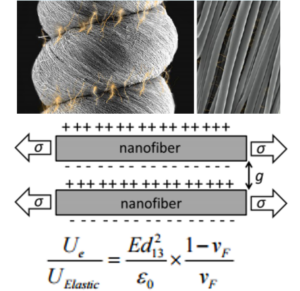
We report on highly stretchable piezoelectric structures of electrospun PVDF-TrFE nanofibers. We fabricated nanofibrous PVDF-TrFE yarns via twisting their electrospun ribbons. Our results show that the twisting process not only increases the failure strain but also increases overall strength and toughness. The nanofibrous yarns achieved a remarkable energy to failure of up to 98 J/g. Through overtwisting process, we fabricated polymeric coils out of twisted yarns that stretched up to ∼740% strain. This enhancement in mechanical properties is likely induced by increased interactions between nanofibers, contributed by friction and van der Waals interactions, as well as favorable surface charge (Columbic) interactions as a result of piezoelectric effect, for which we present a theoretical model. The fabricated yarns and coils show great promise for applications in high-performance lightweight structural materials and superstretchable piezoelectric devices and flexible energy harvesting applications.
2014
-
Naraghi M., Chawla, S., “Carbonized Micro- and Nanostructures: Can Downsizing Really Help?”, Materials, 7(5), 3820-3833, (2014)
In this manuscript, we discuss relationships between morphology and mechanical strength of carbonized structures, obtained via pyrolysis of polymeric precursors, across multiple length scales, from carbon fibers (CFs) with diameters of 5–10 µm to submicron thick carbon nanofibers (CNFs). Our research points to radial inhomogeneity, skin–core structure, as a size-dependent feature of polyacrylonitrile-based CFs. This inhomogeneity is a surface effect, caused by suppressed diffusion of oxygen and stabilization byproducts during stabilization through skin. Hence, reducing the precursor diameters from tens of microns to submicron appears as an effective strategy to develop hom
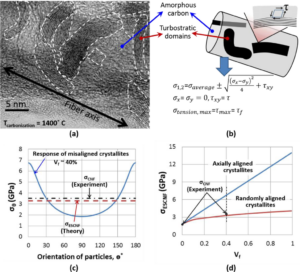 ogeneous carbonized structures. Our research establishes the significance of this downsizing in developing lightweight structural materials by comparing intrinsic strength of radially inhomogeneous CFs with that of radially homogeneous CNF. While experimental studies on the strength of CNFs have targeted randomly oriented turbostratic domains, via continuum modeling, we have estimated that strength of CNFs can reach 14 GPa, when the basal planes of graphitic domains are parallel to nanofiber axis. The CNFs in our model are treated as composites of amorphous carbon (matrix), reinforced with turbostratic domains, and their strength is predicted using Tsai–Hill criterion. The model was calibrated with existing experimental data.
ogeneous carbonized structures. Our research establishes the significance of this downsizing in developing lightweight structural materials by comparing intrinsic strength of radially inhomogeneous CFs with that of radially homogeneous CNF. While experimental studies on the strength of CNFs have targeted randomly oriented turbostratic domains, via continuum modeling, we have estimated that strength of CNFs can reach 14 GPa, when the basal planes of graphitic domains are parallel to nanofiber axis. The CNFs in our model are treated as composites of amorphous carbon (matrix), reinforced with turbostratic domains, and their strength is predicted using Tsai–Hill criterion. The model was calibrated with existing experimental data.
-
Gardea, F., Garcia J. M., Boday D. J., Bajjuri K. M., Naraghi M. and Hedrick J. L., “Hybrid Poly (aryl ether sulfone amide) s for Advanced Thermoplastic Composites”. Macromolecular Chemistry and Physics, 215, 2260-2267 (2014).
-
Gardea, F., Naraghi, and D. Lagoudas, “Effect of Thermal Interface on Heat Flow in Carbon Nanofiber Composites”. Acs Applied Materials & Interfaces, 6(2): p. 1061-1072. (2014)
-
Cai, J, Chawla, S and Naraghi, “Piezoresistive Effect of Individual Electrospun Carbon Nanofiber for Strain Sensing”, Carbon, 77, p738-746 (2014)
-
Roenbeck M. R., Wei X., Beese A., M., Naraghi M., Furmanchuk A., Paci J.T., Schatz G. C., Espinosa H. D., “In Situ Scanning Electron Microscope Peeling To Quantify Surface Energy between Multiwalled Carbon Nanotubes and Graphene”. ACS Nano, 8 124-138 (2014).
-
Naraghi, M., Kolluru P.V., and I. Chasiotis, “Time and strain rate dependent mechanical behavior of individual polymeric nanofibers”. Journal of the Mechanics and Physics of Solids 62: p. 257-275 (2014).
2013
-
Chawla, S., Naraghi, and A. Davoudi, “Effect of twist and porosity on the electrical conductivity of carbon nanofiber yarns.” Nanotechnology, 24(25): p. 255708. (2013)
-
Beese A., Sarkar S., Nair A.; Naraghi M., An Z., Moravsky A., Loutfy R., Buehler M., Nguyen S.B., Espinosa H., “Bio-Inspired Carbon Nanotube-Polymer Composite Yarns with Hydrogen Bond-Mediated Lateral Interactions”, ACS Nano, 7, p. 3434-3446 (2013)
-
Papkov D., Beese A. M., Goponenko A., Zou Y., Naraghi M., Espinosa H. D., Saha B., Schatz G. C., Moravsky A., Loutfy R., Nguyen S. T., Dzenis Y., “Extraordinary Improvement of the Graphitic Structure of Continuous Carbon Nanofibers Templated with Double Wall Carbon Nanotubes” ACS Nano, 7, p. 126-142 (2013).
2012
-
Naraghi M., Bratzel G. H., Filleter T., An Z., Wei X., Nguyen S. T., Buehler M. J. and Espinosa H. D., “Atomistic Investigation of Load Transfer Between DWNT Bundles “Crosslinked” by PMMA Oligomers”, Advanced Functional Materials, 23, p. 1883-1892 (2012)
-
Espinosa H. D., Filleter T. and Naraghi M., “Multiscale experimental mechanics of hierarchical carbon-based materials”, Review article, Advanced Materials, 24, p. 2805-2823 (2012)
-
Filleter T., Yockel S., Naraghi M., Paci J. T., Compton O. C., Mayes M. L., Nguyen S. T., Schatz G.C., Espinosa H. D. “Experimental-Computational Study of Shear Interactions within Double-Walled Carbon Nanotube Bundles”, Nanoletters, 12, pp 732-742 accepted (2012)
2011 and older
-
Arshad S. N., Naraghi M. and Chasiotis I. “High strength carbon nanofibers derived from electrospun PAN”, Carbon, 49, p. 1710-1719 (2011).
-
Naraghi M., Arshad S. N. and Chasiotis I. “Molecular orientation and mechanical property size effects in electrospun polyacrylonitrile nanofibers”, Polymer, 7, p. 1612-1618 (2011).
-
Naraghi M., Filleter T., Moravsky A., Locascio M., Loutfy R., Espinosa H. D. “A Multiscale Study of High Performance Double-Walled Nanotube Polymer Fibers”, ACS nano, 4, pp. 6463-6476 (2010).
-
Naraghi M, Ozkan T, Chasiotis I., Hazra S. S. and de Boer M. P. “MEMS platform for on-chip nanomechanical experiments with strong and highly ductile nanofibers”, Journal of Micromechanics and Microengineering, 20, 125022 (2010).
-
Ozkan T, Naraghi M and Chasiotis I. “Mechanical strength of vapor grown carbon nanofibers”, Carbon, 48, p. 239-244, (2010).
-
Naraghi M and Chasiotis I (2008) “Optimization of comb-driven devices for mechanical testing of polymeric nanofibers with large deformations” Journal of Microelectromechanical Systems 18 (5), p. 1032-1046, (2009).
-
Invited Paper –Best paper award
– Naraghi M., Chasiotis I. and Hilton H. H., “Theory of Designer Nano –Viscoelastic Composites” Proceedings of the World Scientific and Engineering Academy and Society Conference Continuum Mechanics-09, Cambridge, UK, February p. 225-233(2009).
-
Naraghi M., Chasiotis I., Kahn H., Yongkui W., Yuris D. “Novel method for mechanical characterization of polymeric nanofibers”, Review of Scientific Instruments 78, p. 085108 (2007).
-
Naraghi M., Chasiotis , Kahn H., Yongkui W. and Yuris D. “Mechanical deformation and failure of electrospun polyacrylonitrile nanofibers as a function of strain rate”, Applied Physics Letters 91, 151901 (2007).
-
Naraghi M., Chasiotis I., Yongkui W. and Yuris D. Kahn H., “The Effect of Strain Rate on the Mechanical Behavior of 10-micron Long Polymeric Nanofibers”, Proceedings of the Materials Research Society 948 E, p. 1-6, (2006).
Conference Proceedings
-
Chawla S., Gardea F., Lagoudas D. and Naraghi M., “Carbon Nanofibers as a means to Enhance Composites Fracture Toughness”, American Society for Composites 27th Technical Conference, October 1-3, Arlington, Texas, (2012)
-
Naraghi M. and Chasiotis I. “Viscoelastic and viscoplastic mechanical behavior of polymeric nanofibers: An experimental and theoretical approach” Proceedings of the Society for Experimental Mechanics, pp. 1349-1354 (2011).
-
Naraghi M. and Chasiotis I. “Fabrication-Properties Relationship in Polymeric Nanofibers” Proceedings of the Society for Experimental Mechanics, pp. 2032-2037 (2009).
-
Ozkan T., Naraghi M. and Chasiotis I. “Mechanical Properties of Individual Carbon Nanofibers” Proceedings of the Society for Experimental Mechanics, pp. 545-551 (2009).
-
Ozkan T., Naraghi M. and Chasiotis I. “Mechanical Strength of Pyrolytically Stripped and Functionalized Heat Treated Vapor Grown Carbon Nanofibers” Proceedings of the Society for Experimental Mechanics, pp. 1108-1113 (2008).
-
Naraghi M. and Chasiotis I. “Scale and Strain Rate Effects on the Mechanical Behavior of Electrospun Nanofibers” Proceedings of the Society for Experimental Mechanics 812-816 (2007).
-
Naraghi M., Chasiotis I., Zhigilei L.V., Ballarini R., Eppell S. and Aifantis E.C. “NIRT: Novel Experiments and Models for Nanomechanics of Polymeric and Biological Nanofibers” NSF Design, Service and Manufacturing Grantees and Research Conference, St. Louis, MO, July (2006).
-
Kazemi M.T., Naraghi M. and Vossoughi Shahvari, F. “Fracture Energy Determination of SFRC from Notched Beam Tests”, Proceedings of BEFIB, Italy, (2004).
Book Chapters
-
Gardea F., Lagoudas D. and Naraghi M., “Active Damping in Polymer-based Nanocomposites”, Mechanics of Composite and Multi-functional Materials, Volume 7, 2016
-
Naraghi M. (2012), Book Chapter “Graphitic Carbon Nanomaterials for Multifunctional Nanocomposites” in Mechanics and Design of Smart Composites, CRC Press Taylor and Francis
-
Naraghi M. (Editor – 2011) “Carbon Nanotubes”. The book contains the contribution of scientists from all over the world, and covers a wide range of scientific and technological issues about carbon nanotubes, including their synthesis, chemical treatments, and applications.
-
Chasiotis I. and Naraghi M (2009), Book chapter: “Mechanics of electrospun polymer nanofibers as pre-cursors to carbon nanomaterials” in Major Accomplishments in Composite Materials and Sandwich Structures – An Anthology of ONR Sponsored Research. Editor: Emmanuel Gdoutos, Springer
-
